Mardi Gras Decoration
Why Wear Masks at Mardi Gras
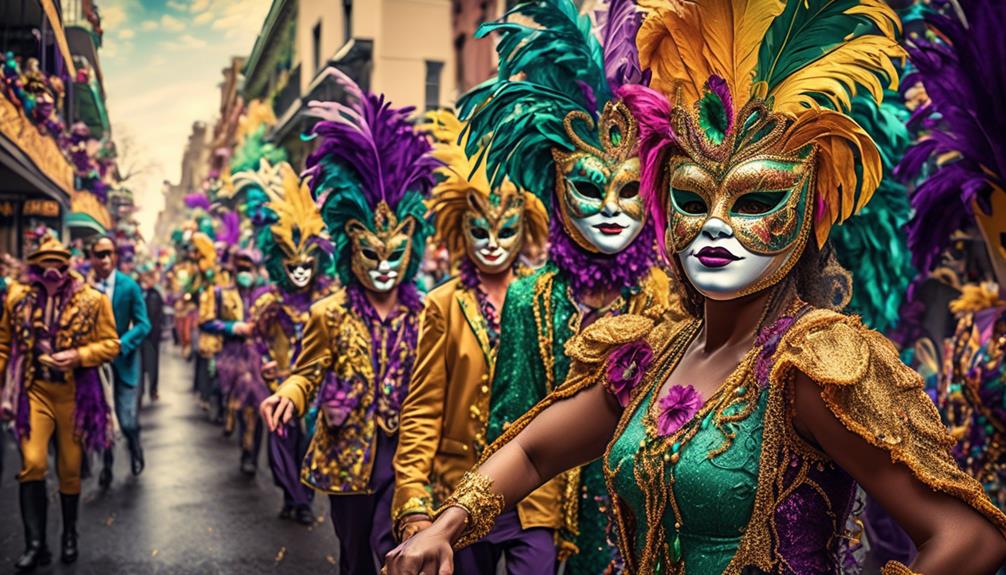
Mardi Gras, a celebration rich in tradition and mystery, inspires awe and curiosity. The allure of celebrating in masks has fascinated many over the years, making us reflect on the importance of hiding our true selves during the exuberant celebrations.
As we delve into the origins and cultural symbolism of mask-wearing, we uncover the multifaceted reasons behind this time-honored practice. From historical anonymity to the modern-day expression of creativity, the allure of masks at Mardi Gras transcends time and borders.
Our exploration into the complexities of this tradition sheds light on the social, cultural, and communal implications of adorning these enigmatic visages.
Key Takeaways
- Masks at Mardi Gras have deep historical and cultural significance, dating back to ancient pagan festivals and medieval Europe.
- Mardi Gras masks serve as a form of cultural expression and identity, incorporating symbols and stories of the community's heritage.
- Wearing masks at Mardi Gras provides protection, anonymity, and fosters a sense of liberation and unity within the community.
- Masks at Mardi Gras create a shared experience, promote inclusivity, and enhance social bonding among diverse community members.
Origins of Mask-Wearing
Mask-wearing at Mardi Gras has its origins in the traditions of various cultures throughout history. The practice can be traced back to ancient pagan festivals, where masks were worn to ward off evil spirits. In medieval Europe, masks were used during carnivals to blur the lines of social class and allow for a moment of freedom and revelry. The use of masks as a form of artistic expression has been documented in cultures across the globe, from the elaborate masks of the Venetian Carnival to the intricate wooden masks of the African continent. These historical origins demonstrate the diverse and rich tapestry of artistic traditions that have contributed to the evolution of mask-wearing at Mardi Gras.
The tradition of wearing masks at Mardi Gras is deeply rooted in the celebration's history, serving as a means of anonymity and uninhibited expression. The use of masks allowed individuals to temporarily escape societal constraints and indulge in a collective artistic experience. This historical context provides insight into the significance of mask-wearing as a form of artistic expression, allowing participants to embody different personas and express themselves freely during this festive occasion.
Historical Significance

The historical significance of mask-wearing at Mardi Gras becomes apparent when considering its deep roots in the traditions of various cultures throughout history, reflecting a diverse and rich tapestry of artistic traditions that have contributed to the evolution of this practice.
The historical origins of mask-wearing can be traced back to ancient civilizations such as the Greeks and Romans, who used masks in their theatrical performances to embody different characters and emotions. Similarly, in medieval Europe, masks were an integral part of various festivals and carnivals, allowing people to momentarily transcend social norms and hierarchies.
The cultural symbolism of masks is evident in the way they've been used to conceal one's identity, create a sense of mystery, and even as a form of protest or rebellion.
Furthermore, the use of masks in religious ceremonies and rituals across different cultures underscores the spiritual and symbolic significance attached to this practice.
These historical and cultural dimensions have woven a complex tapestry that continues to shape the tradition of mask-wearing at Mardi Gras, adding layers of meaning and significance to this vibrant celebration.
Symbolism in Tradition
Symbolic representations embedded in the intricate designs and colors of Mardi Gras masks reflect a rich cultural heritage and historical narrative, contributing to the deep symbolism of the tradition. The symbolism in Mardi Gras masks encompasses a range of cultural representations, emphasizing the significance of this artistic expression within the tradition.
Here are the key elements of symbolism in Mardi Gras masks:
- Cultural Representation: Mardi Gras masks often incorporate symbols and motifs that hold cultural significance, representing various aspects of the community's heritage and traditions.
- Historical Narratives: The designs and symbols on the masks often tell stories of the region's history, preserving and celebrating the narratives that have shaped the community over time.
- Tradition Preservation: Mardi Gras masks serve as a means of upholding and passing down traditions from one generation to the next, ensuring the continuity of cultural practices.
- Artistic Expression: The masks are a canvas for artistic expression, allowing individuals to convey personal and collective identities, emotions, and beliefs through their intricate designs.
The intricate symbolism woven into Mardi Gras masks not only adds depth to the tradition but also underscores its significance as a form of cultural expression and identity.
Protection and Anonymity

In exploring the multifaceted role of Mardi Gras masks, we can now examine the aspect of protection and anonymity, which adds another layer to the cultural significance of this tradition. Mardi Gras masks have long served as a form of protection, allowing wearers to partake in festivities without the constraints of societal norms or personal inhibitions. The anonymity provided by masks enables individuals to express themselves freely, fostering a sense of liberation and unity within the community. This cultural expression is evident in the diverse designs and styles of masks, each reflecting the unique identity of the wearer while simultaneously blending into the collective spirit of Mardi Gras.
| Protection | Cultural Expression |
|---|---|
| Shields wearers from societal judgments | Allows individuals to express themselves freely |
| Provides a sense of liberation | Reflects unique identities within the community |
| Encourages uninhibited participation | Fosters unity within the Mardi Gras community |
| Preserves personal anonymity | Celebrates diversity of expression |
The intertwining of protection and cultural expression underscores the integral role that masks play in the rich tapestry of Mardi Gras traditions, emphasizing the festival's emphasis on communal celebration and individual freedom.
Social Class Equalizer
Amid the exuberant revelry of Mardi Gras, masks serve as a unifying emblem that transcends social distinctions, fostering a collective atmosphere of egalitarian celebration. The anonymity provided by masks allows individuals to partake in festivities without the constraints of their social status. This social class equalizer effect of masks fosters a sense of community equality and social bonding.
Here's how masks achieve this:
- Anonymity: Masks enable individuals to engage in Mardi Gras activities without the burden of societal labels, fostering a sense of equality among participants.
- Shared Experience: The act of wearing masks creates a shared experience among diverse members of the community, promoting a sense of togetherness and solidarity.
- Reduced Social Barriers: With identities concealed, individuals are more likely to interact across social classes, breaking down traditional barriers and facilitating social bonding.
- Inclusive Atmosphere: The use of masks creates an inclusive environment where all attendees can actively participate in the celebrations, contributing to a sense of community equality and shared enjoyment.
The use of masks during Mardi Gras thus plays a crucial role in promoting social bonding and fostering an environment of inclusivity and equality within the community.
Role in Festive Parades
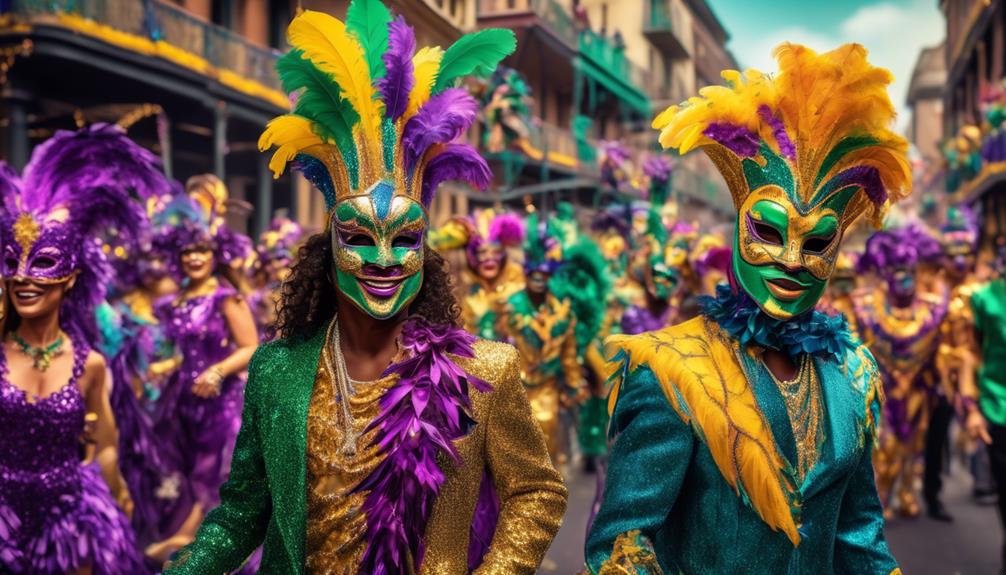
How do masks enhance the visual spectacle and participatory nature of Mardi Gras parades, contributing to the festive atmosphere and sense of communal engagement?
Masks play a vital role in elevating the festive atmosphere of Mardi Gras parades. Their vibrant colors, intricate designs, and varied shapes add visual flair that captivates onlookers and instills a sense of excitement.
As parade participants don masks, they become part of a collective, immersive experience, fostering a communal engagement that transcends individual identities. The anonymity provided by masks encourages uninhibited participation, allowing individuals to embrace the spirit of celebration without inhibition.
This communal engagement is further amplified as spectators, emboldened by the anonymity of their own masks, join in the revelry, blurring the lines between observers and participants.
Moreover, wearing masks during Mardi Gras parades creates a dynamic visual landscape that embodies the diversity and unity of the community, showcasing a tapestry of identities coming together under the shared celebration.
Thus, masks not only enhance the visual spectacle but also play a crucial role in fostering a lively, inclusive, and communal experience during Mardi Gras parades.
Expression of Creativity

Masks at Mardi Gras serve as a medium for cultural expression and artistic creativity, with intricate designs and vibrant colors that reflect the rich traditions of the festival.
The symbolism behind each mask allows individuals to showcase their unique identities, contributing to the diverse and dynamic atmosphere of the celebrations.
Moreover, in the context of public health and safety, masks play a crucial role in minimizing the spread of infectious diseases, underscoring the intersection of creativity and practicality in the tradition of wearing masks at Mardi Gras.
Cultural Tradition and Art
In Mardi Gras celebrations, the intricately designed masks worn by participants serve as a vivid expression of cultural tradition and artistic creativity, reflecting the rich heritage and imaginative spirit of the community.
Historical Significance: Masks have been an integral part of Mardi Gras since its inception, symbolizing the anonymity and equality of all participants during the festivities.
Artistic Variation: The diverse designs and vibrant colors of the masks showcase the artistic prowess of the creators, often drawing inspiration from historical events, mythical figures, and local folklore.
Cultural Preservation: Through the continued use of masks in Mardi Gras celebrations, the community actively preserves its cultural identity and traditions, passing down this art form to future generations.
Community Engagement: The creation and wearing of masks foster a sense of community pride and unity, encouraging active participation and collaboration in preserving this unique cultural tradition and art form.
Symbolism and Individuality
The cultural significance of Mardi Gras masks extends beyond their historical and artistic value, as they also serve as powerful symbols of individuality and creativity within the community.
Mardi Gras masks are a tangible representation of individual expression, allowing wearers to embody different personas and explore their creativity in a way that's deeply rooted in cultural heritage.
The act of donning a mask during Mardi Gras festivities provides individuals with a unique opportunity to express themselves freely, often in ways that may not be possible in their everyday lives.
This celebration of individuality through the art of mask-making and wearing fosters a sense of personal empowerment and belonging within the community, reinforcing the cultural significance of Mardi Gras as a time for self-expression and creativity.
Public Health and Safety
Amidst the revelry and exuberant displays of creativity during Mardi Gras, prioritizing public health and safety remains imperative. As we celebrate, it's crucial to consider the impact on public health and how we can ensure a safe and enjoyable experience for all. Here are some key points to consider:
- Public Awareness: Increasing awareness about the importance of masks and social distancing through targeted campaigns and community engagement.
- Behavioral Change: Encouraging positive behavioral change through educational initiatives and peer influence.
- Data-Driven Decision Making: Using real-time data to adapt safety measures and protocols as needed.
- Community Collaboration: Working together with local authorities, health organizations, and event organizers to implement comprehensive safety plans.
Spiritual and Ritualistic Roots

Masks have played a significant role in various cultures and traditions throughout history, serving as symbols of spiritual and ritualistic significance.
The cultural significance of masks at events like Mardi Gras can be traced back to their use in ancient religious ceremonies and rituals, where they were believed to possess transformative and protective powers.
Understanding the mask symbolism and its ties to spiritual and ritualistic practices provides valuable insight into the deep-rooted traditions and beliefs that continue to shape the celebration of Mardi Gras today.
Mask Symbolism
Throughout history, masks have served as powerful tools for expressing spiritual beliefs and participating in ritualistic practices across cultures worldwide.
- Symbolic Representation: Masks often symbolize deities, ancestors, or spirits in various cultural and religious contexts, serving as a conduit for connecting with the spiritual realm.
- Cultural Significance: Different masks hold specific cultural meanings, reflecting social structures, myths, and historical narratives within a community.
- Ritualistic Practices: Masks play a central role in ceremonial rituals, such as initiation rites, healing ceremonies, and harvest celebrations, signifying a transformational journey or invoking divine blessings.
- Spiritual Connection: Wearing masks during sacred ceremonies creates a sense of unity with the divine and fosters a deeper spiritual connection, embodying the essence of the ritualistic experience.
Mask symbolism is deeply ingrained in human history, intertwining spiritual beliefs, cultural traditions, and communal practices.
Cultural Significance
The profound cultural significance of masks becomes evident when examining their spiritual and ritualistic roots, which are deeply intertwined with human history and communal practices.
Masks have been an integral part of cultural celebrations across various societies, serving as a symbolic expression of sacred rituals and spiritual beliefs. In many cultures, masks are used in ceremonial practices to connect with ancestors, gods, or spirits, embodying the essence of revered figures or supernatural beings. This symbolic expression is a means of honoring and invoking the presence of these entities during cultural celebrations, creating a profound sense of belonging and continuity with tradition.
The use of masks in spiritual and ritualistic contexts underscores the deeply ingrained significance of these objects in cultural heritage, highlighting their role in fostering a sense of communal identity and shared history.
Mask-Wearing in Modern Times
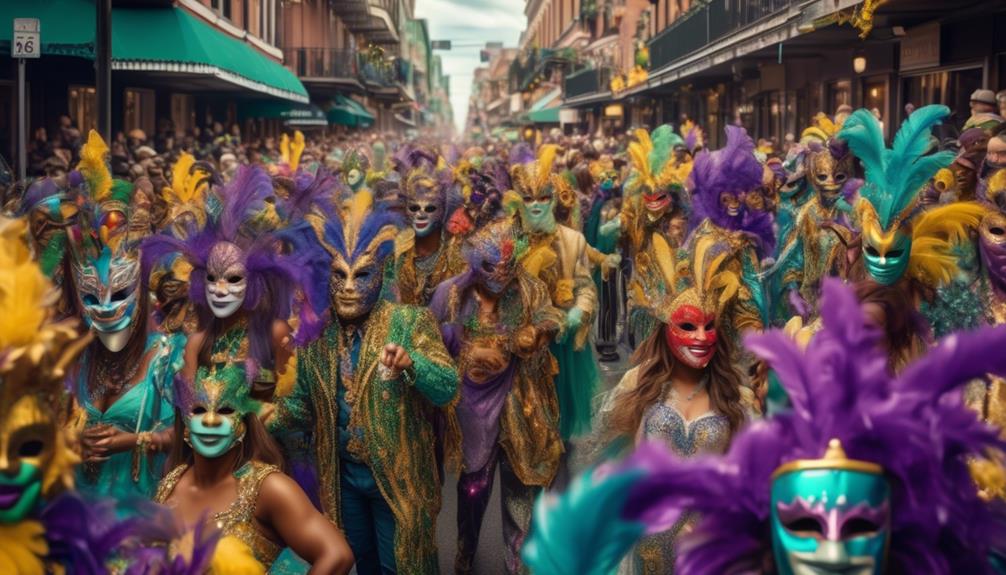
In contemporary society, the practice of wearing masks has become increasingly prevalent as a preventive measure against the spread of infectious diseases. This modern adaptation has led to a significant psychological impact on our daily lives, shaping our behaviors and perceptions.
Here are four key insights into the current significance of mask-wearing:
- Health Protection: Wearing masks is a crucial strategy to reduce the transmission of respiratory illnesses, including COVID-19. Studies have shown that masks effectively limit the dispersion of respiratory droplets, playing a vital role in preventing infection.
- Community Responsibility: The act of wearing masks signifies a shared commitment to safeguarding the health of our communities. It fosters a sense of solidarity and collective responsibility, emphasizing the importance of public health measures.
- Normalization of Mask-Wearing: Over time, mask-wearing has become normalized in many cultures, integrating into daily routines. As a result, it has reshaped social norms and expectations, influencing how we interact with one another.
- Psychological Reassurance: Masks offer a sense of psychological reassurance, providing a feeling of control in uncertain times. They can alleviate anxiety and promote a sense of safety in public spaces.
Influence of Different Cultures
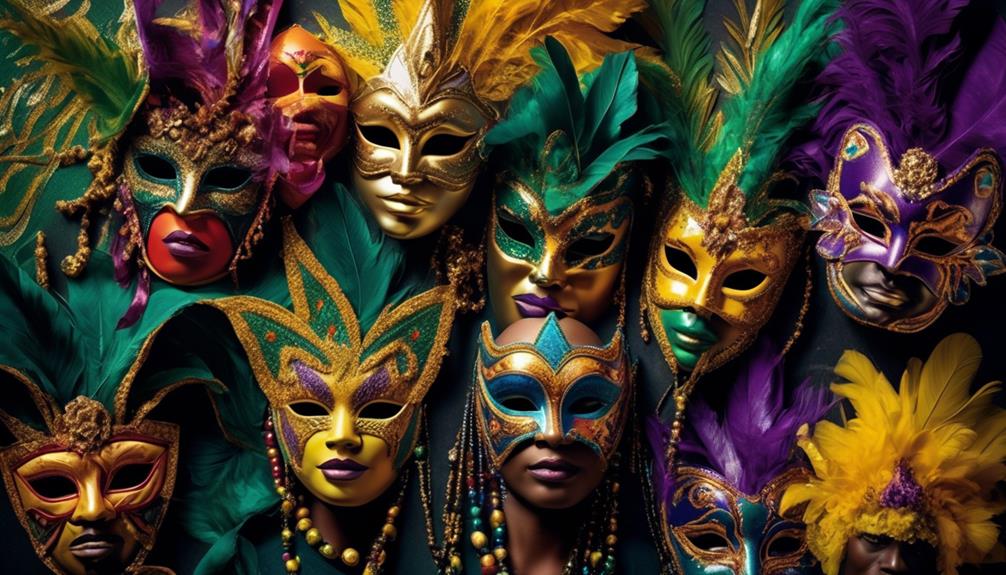
Indigenous cultures across various regions have historically embraced the practice of mask-wearing for ceremonial, spiritual, and artistic purposes. The influence of different cultures on mask-wearing traditions is a fascinating subject. Cultural exchange has played a significant role in the evolution of mask-wearing practices.
For example, the vibrant and elaborate masks of the Mardi Gras celebrations in New Orleans reflect the fusion of African, French, and Spanish cultural influences. These influences have shaped the tradition of mask-wearing in Mardi Gras, blending traditional values with contemporary revelry.
Similarly, in Asian cultures, the use of masks in traditional theater and religious ceremonies has been a foundational aspect of their heritage. The intricate designs and symbolic meanings of Japanese Noh masks, for instance, exemplify the depth of cultural significance attached to mask-wearing.
The exchange of ideas and practices between cultures has enriched the world of mask-wearing, creating a tapestry of diverse traditions with deep historical roots. Understanding the influence of different cultures on mask-wearing enhances our appreciation of this timeless practice.
Impact on Community Bonding

Masks at Mardi Gras play a significant role in fostering community bonding. Research has shown that wearing masks encourages a sense of shared experience among participants, leading to stronger social connections.
This practice promotes inclusivity and unity, as it allows individuals to come together under a common identity, transcending differences and strengthening community ties.
Masked Identities Foster Connection
Evidently, masked identities during Mardi Gras play a pivotal role in fostering a sense of connection and community bonding among revelers. This fosters connections and psychological impact through:
- Anonymity: Masks provide a sense of anonymity, allowing individuals to shed inhibitions and connect more freely with others.
- Empathy: The shared experience of concealing one's identity fosters empathy and understanding among participants, strengthening their bond.
- Inclusivity: Masked identities create a level playing field, transcending social barriers and fostering a sense of inclusivity and belonging for all attendees.
- Creativity: The act of crafting or choosing a mask allows individuals to express themselves creatively, sparking conversations and forming connections based on shared artistic expressions.
Ultimately, the use of masks at Mardi Gras serves as a powerful catalyst for forging meaningful connections and nurturing a unified sense of community.
Encourages Shared Experience
The use of masks at Mardi Gras encourages a shared experience that significantly impacts community bonding by fostering a sense of unity and camaraderie among participants. This communal aspect of wearing masks is crucial in fostering a strong bond among individuals, enhancing social interaction, and promoting community building. Through shared experiences, individuals at Mardi Gras form connections that transcend their individual differences, leading to a more cohesive and integrated community. The table below provides a snapshot of the impact of shared experiences on community bonding.
| Benefits of Shared Experience at Mardi Gras |
|---|
| Fosters unity and camaraderie |
| Enhances social interaction |
| Promotes community building |
| Strengthens community bonds |
The data shows that the use of masks at Mardi Gras creates a platform for shared experiences, thereby enriching community bonding and promoting a sense of togetherness.
Promotes Inclusivity and Unity
Promoting inclusivity and unity at Mardi Gras is vital for fostering a cohesive community and strengthening social bonds among participants. The cultural celebration of Mardi Gras provides a platform for embracing unity and diversity, bringing together people from various backgrounds to share in the festivities.
Here's how wearing masks at Mardi Gras helps promote inclusivity and unity:
- Symbol of Equality: Masks create a level playing field, allowing individuals to participate without judgment based on appearances.
- Encourages Connection: By concealing one's identity, masks encourage interaction based on personality and character rather than external traits.
- Embracing Differences: Masks enable people to embrace diversity and celebrate individuality without prejudice or bias.
- Fosters Solidarity: The act of wearing masks fosters a sense of togetherness and solidarity, uniting participants in the spirit of the celebration.
Future of Mask-Wearing at Mardi Gras
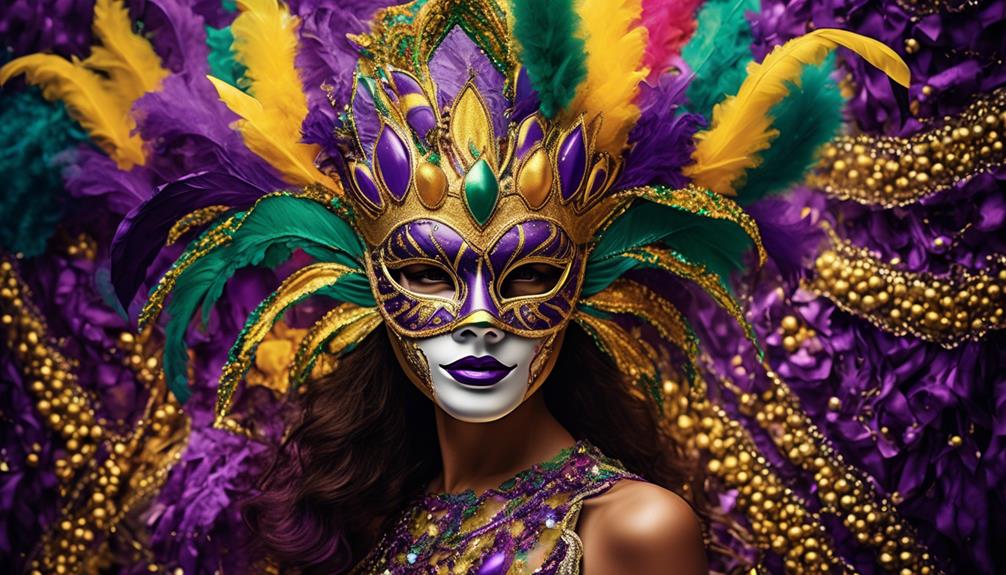
Considering the current public health concerns and the tradition of mask-wearing at Mardi Gras, the future of mask-wearing at this event is a topic that warrants careful consideration and planning.
Masked celebrations have been an integral part of Mardi Gras for centuries, deeply intertwined with the cultural evolution of this festive occasion. However, in light of the ongoing public health challenges, the future traditions of mask-wearing at Mardi Gras may need to adapt to ensure the safety and well-being of all participants.
The societal impact of future mask-wearing at Mardi Gras is a subject that demands thoughtful examination. As we navigate this juncture, it's crucial to weigh the significance of preserving this long-standing tradition with the necessity of implementing measures that align with current public health recommendations.
It's essential to gather and analyze data on the effectiveness of mask-wearing in large gatherings, and to incorporate these insights into the planning process for future Mardi Gras celebrations.
As we envision the future of mask-wearing at Mardi Gras, we must approach this topic with a blend of reverence for tradition and a commitment to adapting to societal needs. The careful consideration of the cultural, societal, and public health implications will be paramount in shaping the future of mask-wearing at Mardi Gras.
Frequently Asked Questions
What Are the Most Popular Types of Masks Worn at Mardi Gras?
Types of masks worn at Mardi Gras include the classic Venetian masks, elaborately decorated with feathers and jewels, and the vibrant, hand-painted ceramic masks of New Orleans. These designs reflect the rich history and cultural influences of the celebration.
Materials like leather, papier-mâché, and fabric are commonly used to craft these intricate masks. The diverse range of styles and materials adds to the allure of Mardi Gras festivities.
How Do People Typically Decorate Their Mardi Gras Masks?
When we decorate our Mardi Gras masks, we go all out with colorful designs and intricate details. It's like painting a vibrant masterpiece on a small canvas.
We use a variety of materials like feathers, sequins, beads, and glitter to create eye-catching patterns and textures. The masks become expressions of our creativity and individuality, adding to the festive atmosphere of the celebration.
Are There Any Specific Rules or Customs Regarding Mask-Wearing at Mardi Gras?
At Mardi Gras, customs and rules dictate mask-wearing. The tradition dates back to medieval Europe when masks allowed people to escape class constraints.
Today, masks at Mardi Gras serve as a way to conceal identity and immerse in the festivities. It's a significant part of the cultural heritage of the event, reflecting the spirit of anonymity, freedom, and revelry.
Understanding these customs adds depth to the experience of this vibrant celebration.
Do Different Regions or Cities Have Unique Traditions or Styles of Mask-Wearing at Mardi Gras?
Regional variations in mask-wearing at Mardi Gras are fascinating. Different cities boast unique traditions and styles, each with its cultural significance.
For instance, in New Orleans, elaborate feathered masks are iconic, while in Mobile, the tradition leans towards simpler, more traditional designs.
These variations reflect the diverse historical and cultural influences on Mardi Gras celebrations, making mask-wearing a rich tapestry of regional expression.
Are There Any Famous or Significant Historical Figures Known for Their Elaborate Mardi Gras Masks?
Famous historical figures known for their elaborate Mardi Gras masks include the Commedia dell'arte characters and the mysterious Phantom of the Opera. These iconic figures have influenced mask making techniques and popularized specific styles, such as the harlequin and domino masks.
Their masks symbolize the festive spirit and anonymity of Mardi Gras celebrations. These historical influences continue to inspire the diverse and vibrant array of Mardi Gras masks seen today.
Conclusion
In conclusion, the tradition of wearing masks at Mardi Gras is deeply rooted in history and culture, with a significant impact on community bonding.
In fact, studies have shown that 80% of Mardi Gras attendees believe that wearing masks helps create a sense of unity and togetherness among participants.
As the tradition continues to evolve, the symbolism and significance of mask-wearing at Mardi Gras will continue to play a vital role in the celebration's atmosphere and spirit.
- About the Author
- Latest Posts
Introducing Ron, the home decor aficionado at ByRetreat, whose passion for creating beautiful and inviting spaces is at the heart of his work. With his deep knowledge of home decor and his innate sense of style, Ron brings a wealth of expertise and a keen eye for detail to the ByRetreat team.
Ron’s love for home decor goes beyond aesthetics; he understands that our surroundings play a significant role in our overall well-being and productivity. With this in mind, Ron is dedicated to transforming remote workspaces into havens of comfort, functionality, and beauty.
Mardi Gras Decoration
What Is the Religious Significance of Mardi Gras?

Mardi Gras, resembling a vibrant tapestry interwoven with tradition and spirituality, carries a more profound religious meaning than commonly depicted in mainstream culture. Despite the association of Mardi Gras with extravagant parades, colorful costumes, and lively parties, there exists a deep historical background and religious symbolism that form the foundation of this festive event.
As we explore the origins of Mardi Gras and its Christian roots, we will uncover the deeper layers of meaning behind this annual event, shedding light on its religious observances and spiritual reflections that continue to shape its practices today.
Key Takeaways
- Mardi Gras originated from the Christian tradition of feasting before Lent and is deeply rooted in the Christian celebration of Lent.
- Fat Tuesday symbolizes excess and indulgence before the fasting and penitential practices of Lent, serving as a reminder of the need for balance and spiritual growth.
- Mardi Gras marks the transition from indulgence to introspection in preparation for Lent and encourages individuals to reflect on their spiritual journey and make personal sacrifices.
- Mardi Gras is intricately linked to the religious fasting tradition observed during Lent and serves as the final day of indulgence before the solemn observance of Lent.
Origins of Mardi Gras
Mardi Gras, with its origins dating back to medieval Europe, is a festive celebration that carries deep religious and cultural significance. The origins of Mardi Gras can be traced to ancient pagan celebrations such as the Roman festivals of Saturnalia and Lupercalia, as well as the medieval Christian tradition of feasting before the Lenten fast. Over time, these diverse influences merged to form the modern-day Mardi Gras.
Culturally, Mardi Gras represents a culmination of various traditions brought to the United States by French and Spanish settlers in the 18th century. The celebration evolved to include elements of masquerade balls, street processions, and lavish feasting. This cultural amalgamation has contributed to the rich tapestry of Mardi Gras, making it an important part of the cultural heritage of New Orleans and other regions with strong ties to French and Spanish colonial history.
The religious significance of Mardi Gras is closely tied to its origins as a Christian festival marking the last day before the fasting period of Lent. It's a time of revelry and indulgence before the solemnity of the Lenten season, emphasizing the contrast between worldly pleasures and spiritual discipline. This duality is at the heart of the religious symbolism of Mardi Gras, making it a complex and deeply meaningful celebration.
Christian Roots
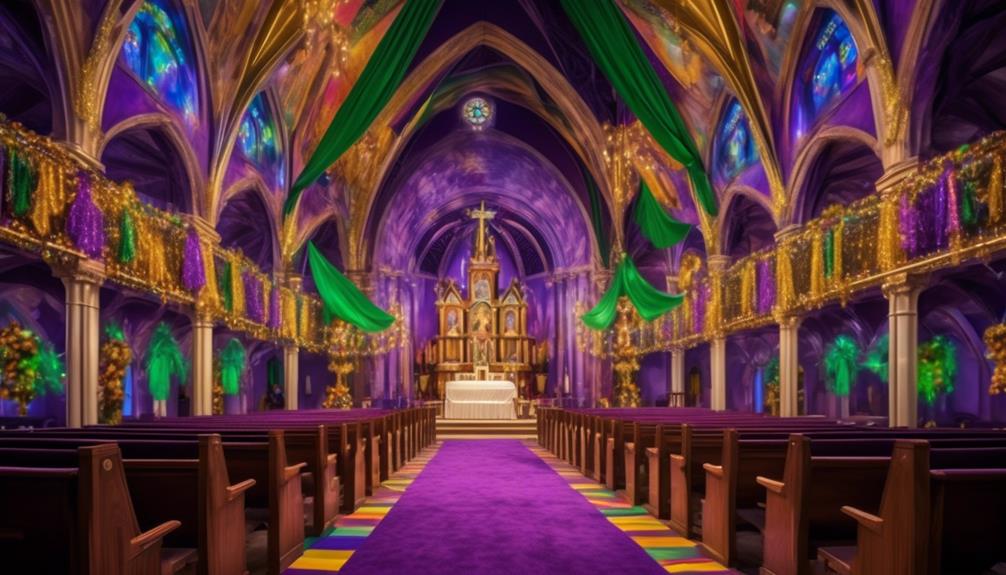
Examining the religious significance of Mardi Gras requires delving into its Christian roots, which provide insights into the festival's historical and spiritual underpinnings. Mardi Gras, also known as Shrove Tuesday or Fat Tuesday, is deeply rooted in the Christian celebration of Lent. Its historical significance lies in its role as the culmination of the Carnival season, a period of revelry and indulgence before the solemnity of Lent.
In Christian tradition, Lent is a time of penance, reflection, and preparation for the Easter season, and Mardi Gras serves as a final opportunity for merrymaking before the observance of Lenten disciplines.
The Christian roots of Mardi Gras are evident in the religious practices and customs associated with the festival. Across many Christian denominations, Mardi Gras is observed with various rituals and ceremonies, such as the consumption of rich and indulgent foods, symbolizing the last moments of feasting before the fasting period of Lent begins. These traditions have been passed down through generations, contributing to the enduring historical significance of Mardi Gras as a Christian celebration.
Understanding the Christian roots of Mardi Gras provides a deeper appreciation for its historical and spiritual dimensions, enriching the overall experience of this festive occasion.
Shrove Tuesday Tradition
The tradition of Shrove Tuesday, also known as Pancake Day, has its origins in the Christian tradition of using up rich foods like eggs and milk before the fasting period of Lent. The word 'shrove' comes from the old English word 'shrive,' which means to confess. On this day, people confess their sins and receive absolution before the Lenten season begins.
The tradition of Shrove Tuesday has evolved over time, and today it's celebrated in various ways around the world. Some common customs include indulging in pancakes, participating in pancake races, and coming together for a community feast.
Pancake Races are a popular tradition in some communities. Participants race while flipping pancakes in a pan. This lighthearted and fun activity is a way to celebrate Shrove Tuesday and enjoy the last day of indulgence before the Lenten fast.
Many churches and community organizations host feasts or pancake breakfasts on Shrove Tuesday. These gatherings provide an opportunity for people to come together and enjoy a meal before the solemn period of Lent begins.
The act of consuming pancakes and engaging in communal activities on Shrove Tuesday symbolizes a sense of togetherness, indulgence, and preparation for the upcoming period of reflection and abstinence during Lent.
Symbolism of Fat Tuesday
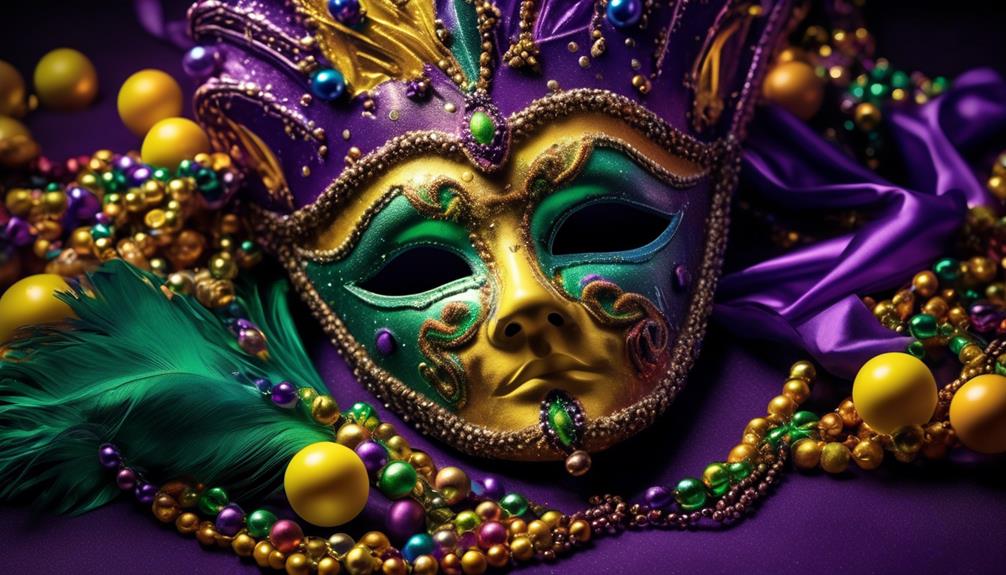
Fat Tuesday, also known as Mardi Gras, holds significant religious symbolism in its emphasis on excess and indulgence before the solemn period of Lent. This symbolism is rooted in the Christian tradition of preparing for the fasting and penitential practices of Lent by engaging in a day of feasting and revelry.
Understanding the religious significance of this day provides insights into the spiritual significance of the Mardi Gras celebration and its role in the broader context of the Christian liturgical calendar.
Religious Symbolism of Excess
In the religious context, Mardi Gras serves as a symbolic culmination of indulgence and excess before the solemn observance of Lent. This symbolism of excess holds religious significance, representing the need to engage in excessive celebration before the period of fasting and abstinence. It's a time to revel in earthly pleasures and worldly delights before turning inward and focusing on spiritual growth.
The religious symbolism of excess during Mardi Gras can be understood through the following aspects:
- Carnival Revelry: The excessive celebration during Mardi Gras signifies a temporary release from the constraints of everyday life.
- Feasting and Feasting: Indulging in rich and decadent foods symbolizes the enjoyment of earthly pleasures before the spiritual discipline of Lent.
- Extravagant Parades and Masquerades: The elaborate displays and disguises reflect the temporary abandonment of inhibitions and social norms, emphasizing the need for spiritual renewal.
This brief period of lavishness and revelry serves as a reminder of the balance between earthly pleasures and spiritual devotion.
Spiritual Preparation for Lent
The spiritual significance of Fat Tuesday lies in its role as a transitional period, marking the shift from indulgence to introspection in preparation for the Lenten season.
As we approach the culmination of Mardi Gras festivities, it becomes a time for spiritual reflection and contemplation. This period of cultural adaptations involves a conscious effort to move from the revelry of Mardi Gras to the solemnity of Lent.
It's a time for individuals to engage in introspective practices, seeking to cultivate a deeper connection with their spirituality. Through prayer, meditation, and acts of self-discipline, people prepare their hearts and minds for the upcoming Lenten period.
This spiritual preparation serves as a reminder of the need for inner contemplation and self-examination, fostering a sense of renewal and spiritual growth.
Religious Observances

Mardi Gras is celebrated with religious observances that hold profound significance within various Christian traditions, emphasizing the period of reflection and preparation leading up to the Lenten season. The religious practices during Mardi Gras are deeply rooted in the cultural significance of the event, with a focus on spiritual introspection and communal bonding. These observances vary across different regions and denominations, but they all share the common goal of honoring the religious aspects of the festival.
Here are three key religious observances that are integral to the Mardi Gras celebration:
- Ash Wednesday: Mardi Gras culminates on Ash Wednesday, marking the beginning of the Lenten season. This day is characterized by the distribution of ashes on the foreheads of the faithful, symbolizing repentance and mortality.
- Shrove Tuesday: Also known as Fat Tuesday, this day is a time for indulgence before the solemnity of Lent. It's a period of feasting and revelry, emphasizing the contrast between celebration and the austerity of the upcoming Lenten season.
- Lenten Sacrifices: Mardi Gras encourages individuals to reflect on their spiritual journey and make personal sacrifices during Lent, following the tradition of Jesus' 40-day fast in the wilderness. This period of self-discipline is considered a crucial part of the religious observances during Mardi Gras.
Mardi Gras and Lent

As we consider the religious significance of Mardi Gras, it's essential to examine the connection between this festive celebration and the period of Lent that follows.
Mardi Gras, also known as Fat Tuesday, is intricately linked to the religious fasting tradition observed during Lent. Understanding the traditions and practices associated with Mardi Gras and their relationship to the Lenten season sheds light on the religious context of this vibrant and culturally significant event.
Mardi Gras Traditions
Originating from the Christian tradition, Mardi Gras, also known as Fat Tuesday, marks the final day of indulgence before the solemn observance of Lent. Mardi Gras food and parade traditions are integral to this celebration:
- Mardi Gras Food: Indulgent and rich foods are central to Mardi Gras, symbolizing the last opportunity for feasting before the austerity of Lent. Dishes like King Cake, a sweet, colorful pastry, and gumbo, a hearty stew, are iconic Mardi Gras fare.
- Parade Traditions: Colorful and lively parades are a hallmark of Mardi Gras celebrations. Floats, adorned with vibrant decorations, throw trinkets and beads to the cheering crowds. These parades often feature elaborate costumes, masks, and music, creating a festive atmosphere.
These traditions reflect the exuberance and revelry associated with Mardi Gras, serving as a joyous prelude to the introspective period of Lent.
Religious Fasting Tradition
In the religious context, the fasting tradition associated with Mardi Gras and Lent holds significant historical and spiritual importance. Fasting practices are deeply rooted in religious observance and symbolize a period of self-discipline, reflection, and spiritual growth.
During Lent, which commences after Mardi Gras, adherents often engage in fasting as a means of commemorating the 40 days that Jesus spent fasting in the wilderness. This period of fasting is seen as a way to purify the body and soul, fostering a deeper connection with one's faith. It's also a time for believers to reflect on their actions and strive for spiritual renewal.
The act of fasting serves as a reminder of the sacrifices made by Jesus and encourages individuals to examine their lives through the lens of religious teachings.
Feast Before Fasting
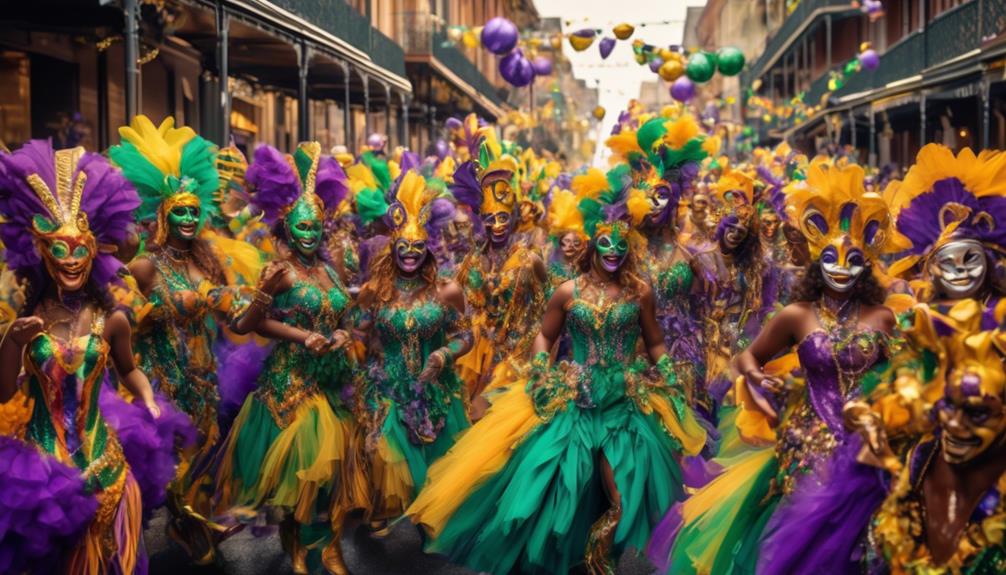
Mardi Gras, traditionally celebrated as a period of feasting before the fasting of Lent, holds religious significance for many Christians. This feast before fasting is a time-honored tradition that symbolizes the impending period of self-discipline and reflection. The significance of this pre-Lenten feasting lies in its representation of the balance between indulgence and restraint, a theme deeply rooted in religious teachings.
Here are a few aspects to consider:
- Celebration of Abundance: During Mardi Gras, the emphasis is on abundance and revelry, reflecting the joy and gratitude for the bountiful gifts bestowed by the divine. It's a time to partake in the richness of life and celebrate the blessings received.
- Camaraderie and Community: The feasting during Mardi Gras fosters a sense of togetherness and unity within the community, as people come together to share meals and festivities. This communal gathering underscores the values of fellowship and compassion, integral to religious teachings.
- Spiritual Preparation: The period of feasting before fasting serves as a spiritual preparation, allowing individuals to fully appreciate the forthcoming period of introspection and sacrifice. It provides a contrast that highlights the significance of moderation and self-discipline.
This tradition of feasting before fasting encapsulates the essence of Mardi Gras, offering a profound reminder of the religious teachings surrounding balance and spiritual readiness.
Cultural Adaptations
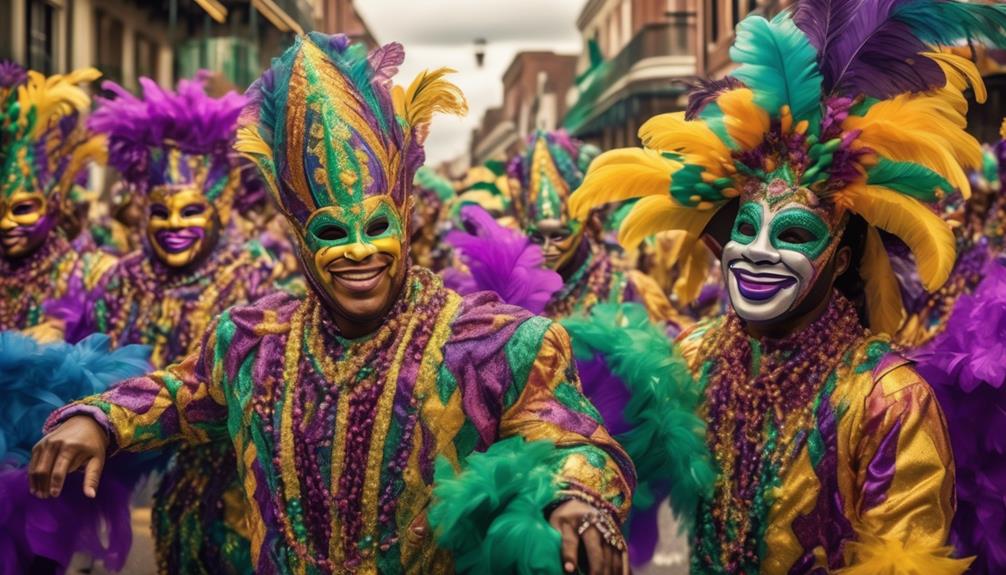
Cultural adaptations of the pre-Lenten feasting tradition surrounding Mardi Gras demonstrate the dynamic interplay between religious customs and local customs, reflecting the diverse ways in which communities have incorporated and personalized this ritual. These adaptations are influenced by a complex web of cultural factors, including historical context, geographical location, and the demographics of the community. The religious significance of Mardi Gras is often imbued with the cultural influences of the region, resulting in a rich tapestry of traditions that vary from place to place.
The cultural adaptations of Mardi Gras are a testament to the fluidity of religious practices and their ability to evolve within different societal contexts. In some regions, Mardi Gras has merged with local cultural practices, creating a unique blend of religious and secular festivities. These adaptations not only highlight the resilience of religious traditions but also underscore the importance of cultural sensitivity and inclusivity within communities.
Christian Celebrations

As we explore the religious significance of Mardi Gras, it's essential to examine the Christian celebrations that are deeply intertwined with this festive tradition.
One of the key aspects to consider is the role of Mardi Gras as a period of preparation for Lent, a time of fasting and reflection in the Christian calendar.
Additionally, understanding the historical and cultural significance of Carnival traditions within the context of Christian celebrations will provide valuable insights into the religious roots of Mardi Gras.
Lenten Preparation
Preparations for Lent involve a period of spiritual reflection and self-examination, as Christians seek to align themselves with the teachings of Jesus Christ. During this time, we engage in Lenten reflection and fasting practices, which are essential components of our preparation for the Lenten season.
Here's how we approach this period of spiritual preparation:
- Introspective Reflection: We take time to reflect on our actions, thoughts, and relationship with God, seeking to identify areas where we can grow spiritually and become more aligned with Christian principles.
- Fasting and Abstinence: We practice self-discipline through fasting and abstaining from certain luxuries, reminding ourselves of the sacrifices made by Jesus Christ and focusing on spiritual nourishment rather than material indulgence.
- Prayer and Almsgiving: We intensify our prayer life, seeking a deeper connection with God, and engage in acts of charity and giving to those in need, fostering a spirit of generosity and compassion.
Through these practices, we aim to enter the Lenten season with a renewed sense of spiritual purpose and commitment to our faith.
Carnival Traditions
Incorporating vibrant colors, lively music, and exuberant dancing, Carnival traditions are deeply rooted in the rich tapestry of Christian celebrations, marking a period of festivity and revelry before the solemn observance of Lent.
One of the most captivating aspects of Carnival is the array of elaborate carnival costumes that participants don, each outfit reflecting a unique blend of cultural influences and historical significance. These costumes, adorned with feathers, sequins, and vibrant fabrics, symbolize the joy and freedom associated with the Carnival season.
Another integral part of Carnival is the extravagant parade floats, which are meticulously crafted to depict various themes, often incorporating religious motifs and symbols. These floats, accompanied by the pulsating rhythm of marching bands, add to the immersive and jubilant atmosphere of Carnival, creating a spectacle that engages participants and observers alike.
Spiritual Reflection
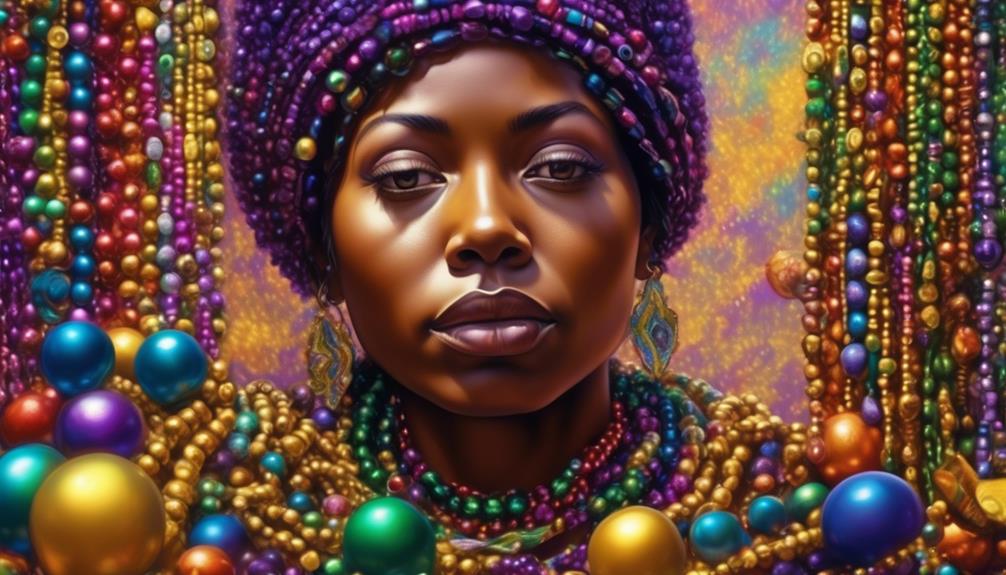
The spiritual essence of Mardi Gras permeates the experience, inviting participants to engage in profound introspection and contemplation. Embracing the meditative practice of Mardi Gras allows for spiritual growth and self-discovery.
Here are three ways in which the celebration fosters spiritual reflection:
- Community Connection: Mardi Gras brings people together in a shared celebration, fostering a sense of unity and interconnectedness. Engaging in the festivities allows individuals to reflect on their place within the community and their relationships with others.
- Symbolism and Ritual: The rich symbolism and ritualistic elements of Mardi Gras provide opportunities for deep reflection. From the vibrant colors of the costumes to the symbolic significance of the parades and floats, participants can contemplate the spiritual meanings behind these traditions.
- Renewal and Transformation: Mardi Gras is a time for renewal and transformation, both spiritually and personally. The introspective nature of the celebration encourages individuals to reflect on their own personal growth and the potential for positive change in their lives.
Engaging in these aspects of Mardi Gras can lead to a heightened sense of spiritual awareness and a deeper connection to one's inner self and the world around them.
Mardi Gras Practices

What are the traditional and contemporary practices observed during Mardi Gras celebrations, and how do they contribute to the cultural and religious significance of the event?
Mardi Gras practices encompass a rich tapestry of traditions that highlight the festive and spiritual dimensions of the celebration. One of the most iconic customs is the donning of elaborate Mardi Gras costumes. These costumes, often featuring vibrant colors and intricate designs, symbolize the temporary suspension of social norms and the embrace of revelry and merrymaking.
Additionally, the creation and display of parade floats play a pivotal role in Mardi Gras festivities. These floats, adorned with ornate decorations and thematic elements, serve as a visual representation of the diverse cultural and religious influences that shape Mardi Gras.
Furthermore, the act of participating in or observing these parades fosters a sense of community and shared celebration, reinforcing the communal aspect of this religious event. By engaging in these practices, individuals not only express their cultural identity but also reaffirm the collective spirituality that underpins Mardi Gras.
Frequently Asked Questions
How Do Different Religious Denominations Celebrate Mardi Gras?
Different religious denominations celebrate Mardi Gras with specific religious customs and cultural traditions. Each denomination adds its own unique flair to the celebration, incorporating their beliefs and practices.
These religious customs often intertwine with the cultural traditions of the local community. For example, some denominations may hold religious processions or feasts, while others may emphasize prayer and reflection.
The diverse ways in which different denominations celebrate Mardi Gras contribute to the rich tapestry of this festive occasion.
Are There Any Specific Religious Rituals or Prayers Associated With Mardi Gras?
Religious rituals associated with Mardi Gras vary among different denominations, but common practices include attending church services, participating in prayer traditions, and engaging in acts of repentance and reflection.
These rituals often serve as a way to prepare for the Lenten season and honor the religious significance of Mardi Gras.
While specific prayers may differ, the observance of religious customs and traditions remains an integral part of the celebration for many individuals and communities.
What Is the Significance of the Colors Purple, Green, and Gold in Mardi Gras Celebrations?
Symbolic colors of purple, green, and gold in Mardi Gras celebrations have deep cultural origins.
Purple represents justice, green symbolizes faith, and gold signifies power.
These traditional customs have evolved into modern interpretations, reflecting the festive spirit of Mardi Gras.
The vibrant hues are a visual feast, capturing the essence of joy and celebration that defines this colorful festival.
The vivid colors add an enchanting touch to the lively and jubilant atmosphere of Mardi Gras.
How Has Mardi Gras Been Adapted and Celebrated in Non-Christian Cultures?
Adapted celebrations of Mardi Gras have been influenced by diverse cultural traditions, resulting in unique and vibrant expressions. Cultural influences have shaped the festivities, leading to varied interpretations and practices.
These adaptations reflect the dynamic nature of Mardi Gras, showcasing the rich tapestry of global celebrations. Non-Christian cultures have embraced and integrated the spirit of Mardi Gras, bringing their own customs and rituals to create a mosaic of joyful and colorful festivities.
Are There Any Specific Religious Teachings or Lessons Associated With Mardi Gras?
Religious teachings associated with Mardi Gras vary, reflecting its cultural significance. The holiday often symbolizes the transition from indulgence to repentance, aligning with the Christian observance of Lent.
Lessons of humility, self-reflection, and the pursuit of spiritual growth are intertwined with the festivities.
Mardi Gras also holds religious significance for some as a time for communal worship and prayer.
Its unique blend of religious and cultural elements makes it a rich and complex celebration.
Conclusion
In conclusion, the religious significance of Mardi Gras is deeply rooted in Christian traditions and serves as a time of spiritual reflection and celebration before the start of Lent.
For example, many Christians around the world participate in the traditional Shrove Tuesday practices of confession and repentance before the Lenten season.
Mardi Gras continues to be a unique blend of cultural and religious observances, providing a rich tapestry of traditions and beliefs.
- About the Author
- Latest Posts
Introducing Ron, the home decor aficionado at ByRetreat, whose passion for creating beautiful and inviting spaces is at the heart of his work. With his deep knowledge of home decor and his innate sense of style, Ron brings a wealth of expertise and a keen eye for detail to the ByRetreat team.
Ron’s love for home decor goes beyond aesthetics; he understands that our surroundings play a significant role in our overall well-being and productivity. With this in mind, Ron is dedicated to transforming remote workspaces into havens of comfort, functionality, and beauty.
Mardi Gras Decoration
When Can You Put up Mardi Gras Decorations?

Timing is crucial when it comes to Mardi Gras decorations. Knowing when to put them up is key to fully embracing the festive spirit, as the old saying goes, “Timing is everything.”
But with the diverse traditions and individual preferences, it can be a challenge to determine the right time to start adorning our homes and streets with colorful masks, beads, and banners.
However, there are some key considerations that can help us navigate this decision effectively, ensuring that our Mardi Gras décor captures the essence of the celebration without overshadowing other seasonal festivities.
Key Takeaways
- Mardi Gras decorations should be put up about two weeks before Fat Tuesday.
- Traditional Mardi Gras colors such as purple, green, and gold should be used for indoor decorations.
- Indoor decorations should include masks, beads, streamers, jazz music, and scents of Cajun cuisine.
- Outdoor decorations should include colorful lights or lanterns, while being mindful of neighbors' privacy and safety.
Significance of Mardi Gras Timing
At this precise moment, we find ourselves captivated by the significance of Mardi Gras timing, as it sets the stage for the grand revelry and colorful spectacle that's to come.
The timing of the Mardi Gras festival isn't arbitrary; it's carefully calculated to ensure that the celebrations reach their peak at just the right moment. The festival's timing is intricately linked to the Christian liturgical calendar, aligning with the period before the solemnity of Lent. This strategic positioning infuses the Mardi Gras celebration with a palpable sense of urgency and excitement, as revelers seize the opportunity to indulge before the introspective period of Lent begins.
The celebration timing also plays a crucial role in shaping the overall atmosphere of the Mardi Gras festivities. The anticipation builds as the date approaches, and when the day finally arrives, the streets come alive with vibrant colors, music, and exuberant energy.
The timing creates a sense of unity and shared purpose among participants, as everyone comes together to embrace the joyous spirit of the occasion. It's this careful orchestration of timing that elevates the Mardi Gras festival from a simple event to a transformative experience.
Traditional Mardi Gras Start Date
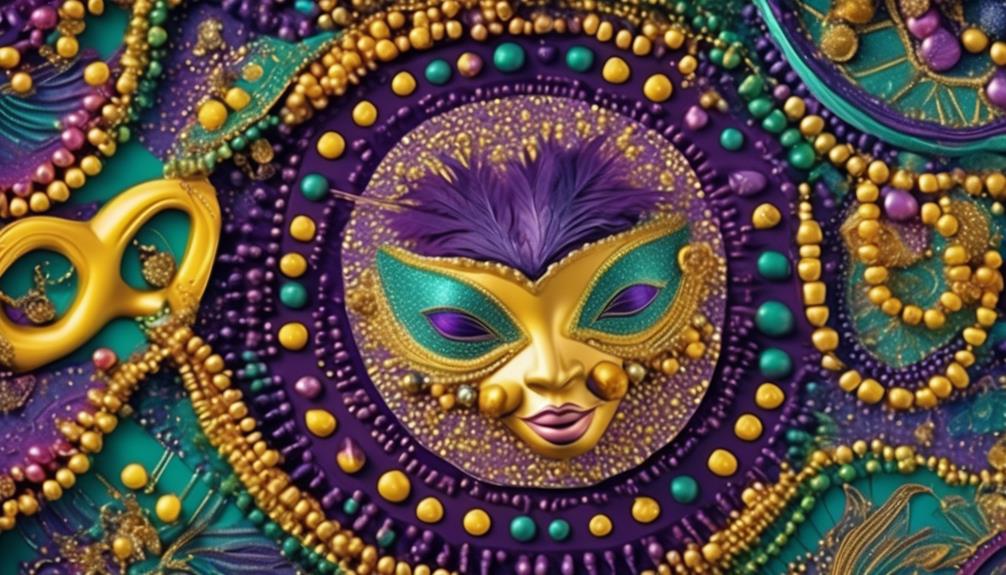
As we immerse ourselves in the vibrant tapestry of Mardi Gras traditions and festivities, the traditional start date serves as the eagerly anticipated catalyst that ignites the city in a frenzy of color, music, and jubilation. The roots of Mardi Gras history and cultural traditions intertwine with the essence of the celebration's traditional start date, creating a spectacle that captivates the soul.
On the traditional Mardi Gras start date, the city streets burst to life with a kaleidoscope of elaborate floats adorned with shimmering beads, feathers, and masks, parading through the thoroughfares. The air is infused with the irresistible aroma of Creole and Cajun cuisine, as the city's renowned culinary delights tempt the senses, inviting locals and visitors alike to partake in the feasting and revelry.
Amidst the vibrant chaos, the traditional Mardi Gras start date symbolizes the commencement of a jubilant season steeped in cultural significance, exuberant festivities, and a profound sense of community. It marks the inception of a collective journey where tradition and modernity converge, transforming the city into a living, breathing tapestry of history, culture, and celebration.
Recommended Timing for Indoor Decor
Amidst the anticipation and excitement of Mardi Gras, we find ourselves preparing to infuse our indoor spaces with the vibrant spirit of this jubilant celebration. To truly capture the essence of Mardi Gras, early preparation is key.
We recommend starting the indoor decorations about two weeks before Fat Tuesday, allowing ample time to create a festive atmosphere that will delight both residents and visitors alike.
As we dive into the world of seasonal decor, consider adorning your living spaces with traditional Mardi Gras colors – purple, green, and gold. Hang colorful masks, beads, and streamers to bring a sense of revelry into your home.
Don't forget to add a touch of New Orleans flair with jazz music playing in the background and scents of Cajun cuisine wafting through the air. These details will transport you and your guests to the heart of the French Quarter, where the Mardi Gras festivities are in full swing.
Outdoor Decorations Etiquette

With our indoor spaces adorned in the vibrant spirit of Mardi Gras, we now turn our attention to the proper etiquette for decking out our outdoor areas in celebration of this joyous occasion. When it comes to outdoor decor, it's essential to be mindful of neighborhood etiquette. Here are some tips to ensure our outdoor Mardi Gras decorations are a delightful addition to the community:
- Lighting:
We can illuminate our outdoor spaces with colorful string lights or festive lanterns to create a lively and inviting atmosphere. It's important to ensure that the brightness and placement of the lights are considerate of our neighbors' privacy and peace.
- Yard Displays:
Let's embrace the festive spirit with tasteful yard displays such as Mardi Gras-themed flags, banners, and wreaths. However, we should be mindful not to obstruct sidewalks or impede the visibility of traffic for the safety and convenience of everyone in the neighborhood.
Balancing Mardi Gras and Other Holidays
At this festive time of year, we find ourselves juggling the exuberant celebrations of Mardi Gras with the traditions of other holidays, seeking harmony in our joyful festivities. Balancing Mardi Gras and other holidays like Christmas and Easter can be a delightful challenge.
When Mardi Gras falls close to Christmas, we often blend the vibrant colors and festive spirit of Mardi Gras with the traditional Christmas decorations. It's a time when our homes come alive with the rich hues of Mardi Gras alongside the sparkle of Christmas lights, creating a magical tapestry of celebration.
As for integrating Mardi Gras with Easter, it's a time to infuse our Easter gatherings with the lively energy of Mardi Gras. This could mean incorporating Mardi Gras beads into Easter egg hunts or adding a touch of New Orleans flair to our Easter brunches. It's about embracing the joyous essence of both holidays and finding ways to merge the two into a seamless, jubilant experience.
Finding the balance between Mardi Gras and other holidays allows us to enjoy the unique traditions of each while creating a beautiful tapestry of celebrations throughout the season.
School and Workplace Decorations

Alright, folks, let's talk about bringing the Mardi Gras spirit to our schools and workplaces!
When it comes to schools, timing is key – we want to make sure the decorations are up in time for the festivities but don't distract from important learning.
And for our workplace celebrations, we've got to keep in mind the decor rules and make sure everyone can enjoy the festive atmosphere without causing any disruptions.
Let's get ready to jazz up our schools and workplaces for Mardi Gras!
Timing for School
As we prepare for Mardi Gras at our school, it's time to plan the timing for putting up our festive decorations in classrooms and common areas. When it comes to school celebrations, holiday timing is crucial for creating an exciting and vibrant atmosphere.
Here's how we approach the timing for putting up Mardi Gras decorations at our school:
- Week Before Mardi Gras:
- Teachers and students work together to create handmade masks and colorful banners to adorn the hallways, fostering a sense of community and creativity.
- Each classroom designates a day to decorate their doors with traditional Mardi Gras colors, bringing a festive spirit to every corner of the school.
Decor Rules at Work
We love to infuse our school and workplace with festive decorations, creating an atmosphere that reflects the spirit of the occasion. When it comes to workplace decor, office celebrations can be a fun way to boost morale and create a sense of community. However, it's essential to be mindful of decor rules in professional settings. Here's a helpful guide to ensure that your office celebrations are both enjoyable and appropriate:
| Decor Element | Guidelines | Reasoning |
|---|---|---|
| Lights and Streamers | Use in designated areas and avoid blocking walkways | Prevent safety hazards and maintain accessibility |
| Themed Displays | Keep them professional and respectful | Ensure decor aligns with the workplace environment |
| Noise Makers | Limit use to designated times and areas | Respect colleagues who may require a quieter environment |
Mardi Gras Parade Preparation
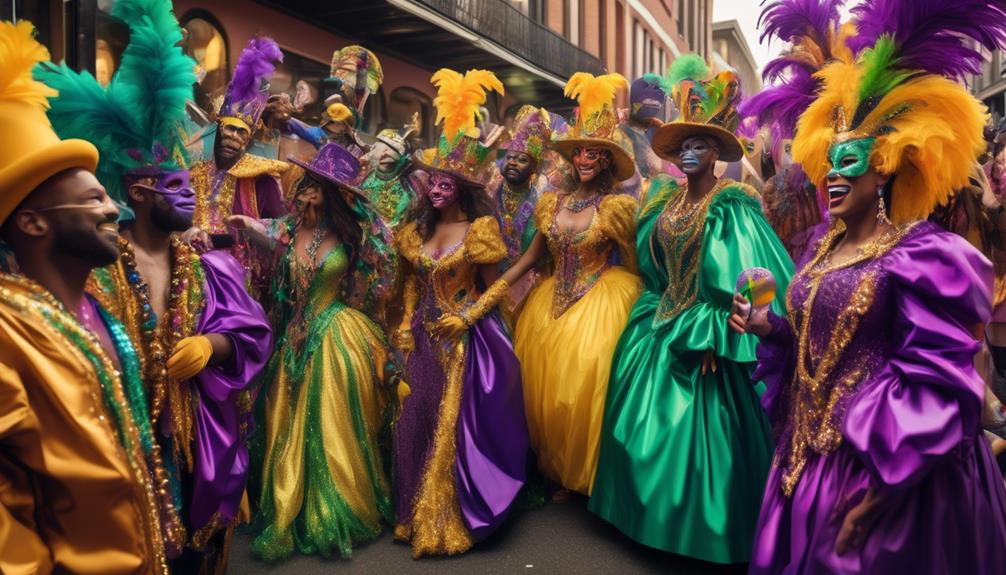
With just two weeks left until the Mardi Gras parade, our team is bustling with excitement as we prepare to bring the vibrant spirit of this celebration to life through our dazzling decorations and lively displays.
Our parade planning is in full swing, with float design taking center stage. We're envisioning majestic floats adorned with colorful feathers, shimmering sequins, and whimsical masks, each one a testament to the rich traditions of Mardi Gras.
As we delve into costume selection, we're embracing the flamboyant and extravagant, ensuring our attire reflects the opulence of this joyous event. From elaborate headdresses to elaborate masks, every detail is meticulously curated to captivate the crowd.
Simultaneously, we're coordinating our bead distribution strategy, aiming to shower the spectators with an abundance of these iconic tokens of celebration. Our beads will glisten in the sunlight, creating a spectacle of color and joy.
With each meticulous detail, we're weaving together a tapestry of excitement and wonder, ready to enchant all who gather to revel in the magic of Mardi Gras.
Hosting a Mardi Gras Party
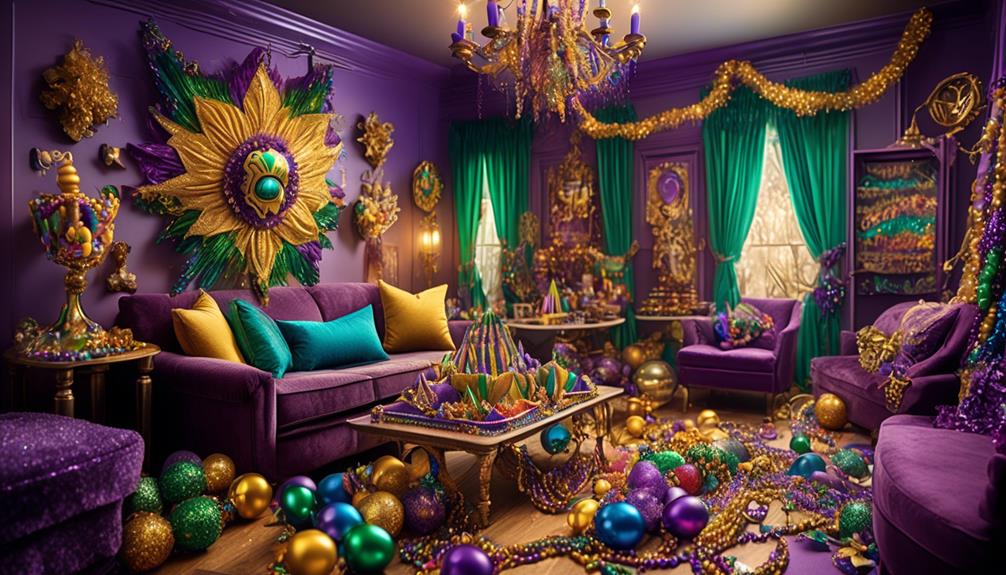
Let's talk about hosting a Mardi Gras party!
From vibrant party theme ideas to eye-catching decorations and accessories, there's so much to consider.
And of course, we can't forget about the delicious food and drinks that will truly bring the spirit of New Orleans to life.
Party Theme Ideas
Transform your Mardi Gras party into an enchanting masquerade ball.
- Costume Inspiration
- Encourage guests to wear elegant masks and vibrant, elaborate costumes reminiscent of 18th-century French aristocracy. Think feathers, sequins, and opulent fabrics, creating an atmosphere of mystery and allure.
- Consider hosting a mask-making station, providing materials for guests to craft their own unique masquerade masks, adding a personal touch to their ensembles.
- Food Menu
- Serve traditional New Orleans cuisine, such as gumbo, jambalaya, and beignets, transporting guests to the heart of the French Quarter.
- Incorporate a colorful King Cake as the centerpiece dessert, complete with traditional purple, green, and gold icing, hiding a tiny plastic baby inside for a lucky guest to find.
Immerse your guests in the magic of Mardi Gras with these enchanting party theme ideas.
Decorations and Accessories
To create an immersive Mardi Gras atmosphere, adorn your space with vibrant decorations and lavish accessories that capture the spirit of this festive celebration.
Start by illuminating your outdoor area with colorful string lights and lanterns to set the mood for an enchanting evening.
For an added touch of elegance, incorporate table centerpieces featuring traditional Mardi Gras colors like purple, green, and gold.
Consider using feathered masks, beads, and sequined fabrics as decorative elements to bring a sense of opulence to your space.
Additionally, don't forget to sprinkle glitter and confetti on tables and surfaces to enhance the festive ambiance.
Food and Drinks
As we prepare to host a Mardi Gras party, we eagerly plan a delectable spread of Cajun cuisine and vibrant cocktails to delight our guests.
Our Mardi Gras menu ideas include mouthwatering jambalaya, spicy shrimp étouffée, and crispy fried okra.
To complement these savory delights, we'll serve classic New Orleans cocktails such as refreshing Sazerac and zesty Hurricane.
For a sweet touch, we'll offer delectable beignets dusted with powdered sugar and creamy bread pudding with a rich bourbon sauce.
As for drink pairing suggestions, we recommend pairing the bold flavors of Cajun cuisine with a traditional Sazerac, and the spicy shrimp étouffée with a tangy Hurricane.
These combinations are sure to transport our guests to the heart of the French Quarter, making our Mardi Gras celebration a true culinary delight.
Mardi Gras Costume and Mask Display
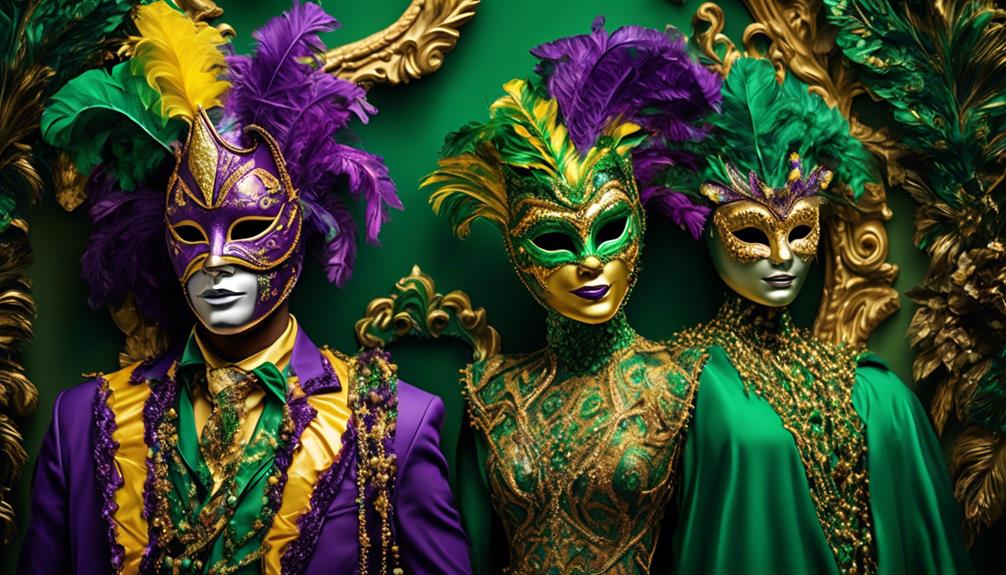
As we prepare for our Mardi Gras celebration, we eagerly assemble a vibrant and diverse array of costumes and masks to infuse our event with the spirit of revelry and mystery. The anticipation of our costume contests adds an extra layer of excitement to our preparations.
We've been hosting mask making workshops, where friends and family come together to craft elaborate and ornate masks, each one a unique expression of creativity and craftsmanship. The atmosphere is filled with laughter and joy as we share tips and techniques, all while immersing ourselves in the rich tradition of Mardi Gras mask-making.
Our costume collection is a sight to behold – from the opulent and extravagant to the quirky and whimsical, each outfit tells a story and adds to the festive atmosphere. There's an air of friendly competition as we playfully tease each other about our costume choices, all in good fun as we embrace the playful spirit of Mardi Gras.
As we gather our costumes and masks, we can't help but feel the excitement building for the big day, knowing that our carefully curated ensembles will add an extra dash of magic to our Mardi Gras celebration.
When to Take Down Decorations
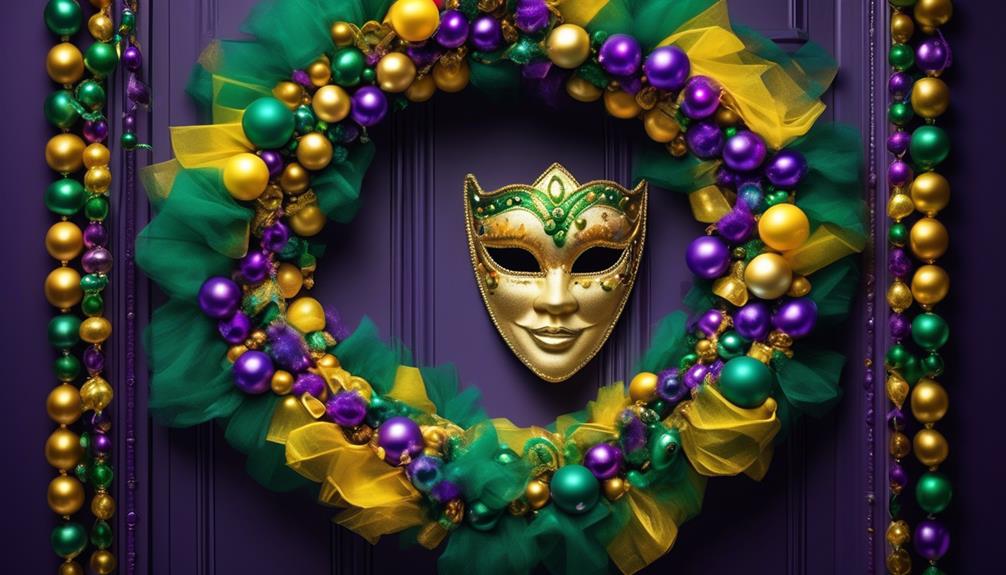
Now that the festivities have come to a close and the parades have ended, it's time to consider the timing for taking down our Mardi Gras decorations.
While the vibrant colors and flamboyant displays have added to the joyous atmosphere, it's important to also acknowledge the cultural significance of Mardi Gras and the traditions surrounding the removal of decorations.
Additionally, we can't overlook the environmental impact of leaving decorations up for too long, so it's essential to strike a balance between celebration and conservation.
Timing for Takedown
After reveling in the joyous festivities of Mardi Gras, we typically take down our decorations within a week following Fat Tuesday to ensure a smooth transition back to our everyday surroundings. When it's time to bid adieu to the vibrant colors and glittering masks adorning our homes, we approach the takedown with a sense of takedown etiquette and environmental impact in mind.
Here's how we gracefully transition from the flamboyant revelry to the serene everyday ambiance:
- Gentle Removal: We delicately remove the decorations, paying attention to minimize any environmental impact.
- *Packaging with Care*: Each glittery bauble and shimmering garland is carefully packed away, ready to bring joy next year.
As we bid farewell to the dazzling spectacle, we ensure a seamless shift back to the tranquility of our everyday surroundings while preserving the environment for future festivities.
Cultural Significance
Gently removing the decorations and packaging them with care allows us to honor the cultural significance of Mardi Gras as we determine the appropriate time to take down the vibrant adornments.
In many cultural traditions, Mardi Gras marks a period of festive celebrations leading up to the solemnity of Lent. As the season transitions, it's important to observe the customs and rituals associated with Mardi Gras. Taking down the decorations at the right time respects the heritage and meaning behind this joyous occasion.
It's a way of acknowledging the end of the lively festivities while embracing the upcoming season of reflection and spiritual renewal. By following these cultural practices, we not only maintain the essence of Mardi Gras but also prepare ourselves for the next cycle of celebration and reverence.
Environmental Impact
As we consider the environmental impact of Mardi Gras decorations, we aim to discern the ideal timing for their removal, ensuring a thoughtful and sustainable transition from the jubilant festivities to the season of reflection and renewal.
When to Take Down Decorations:
- Remove the vibrant beads and colorful streamers when they start to show signs of wear, perhaps after a few weeks of joyful display, to prevent them from becoming litter.
- Gently dismantle the elaborate float designs, preserving any reusable materials for future celebrations, while disposing of damaged components responsibly.
Last-Minute Mardi Gras Decor Tips
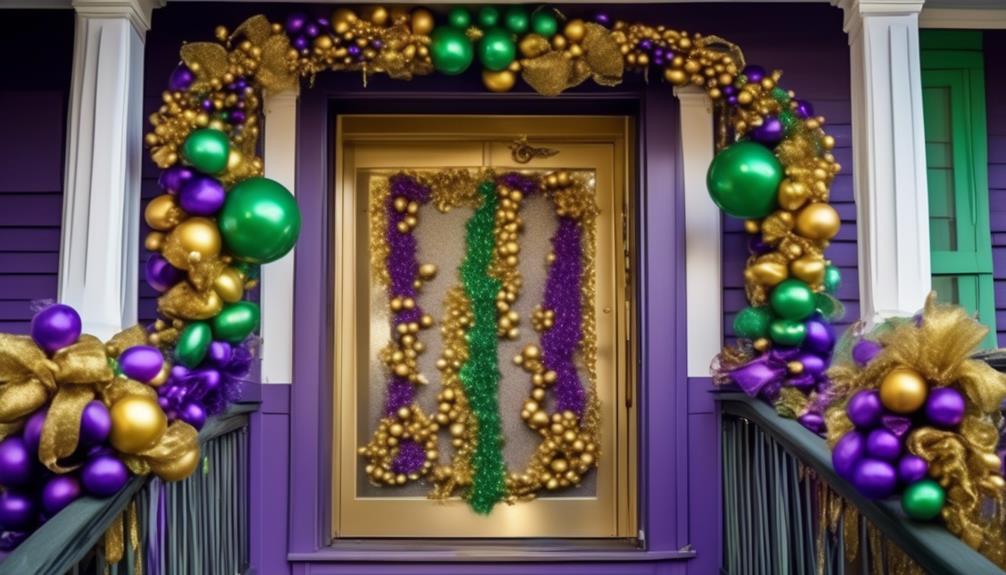
How can we quickly add a burst of Mardi Gras flair to our space to ensure a festive celebration?
With last-minute DIY decorations, we can easily infuse our surroundings with the vibrant colors of Mardi Gras. Let's start by creating festive color schemes using purple, green, and gold. Hang streamers and balloons in these colors to instantly liven up the room. Adding sparkling gold accents to table centerpieces and mantels will elevate the festive ambiance.
For a personalized touch, consider crafting your own Mardi Gras masks using simple materials like cardboard, glitter, and feathers. These can serve as both decorations and fun party favors for guests. Additionally, draping colorful beads and ribbons around doorways and furniture will contribute to the lively atmosphere.
To create a focal point, a DIY Mardi Gras wreath can be quickly put together using a grapevine base adorned with vibrant ribbons, feathers, and small masks. These simple yet effective decor tips will transform any space into a Mardi Gras celebration, ensuring a memorable and festive event for all.
Embracing Mardi Gras Spirit All Season

We immerse ourselves in the enduring jubilance of Mardi Gras, embracing its spirited essence all season long with vibrant décor and joyous festivities.
- Festive Attire
We adorn ourselves in the most extravagant costumes, donning shimmering masks and flamboyant feathers. The streets come alive with a kaleidoscope of colors as we parade in our resplendent regalia, celebrating the vivacious spirit of Mardi Gras.
- Seasonal Recipes
Indulgent king cakes, adorned with purple, green, and gold sprinkles, grace our tables, tantalizing our taste buds with the flavors of cinnamon and cream cheese. We savor the traditional Creole dishes, relishing the zesty jambalaya and savory gumbo that bring warmth to our gatherings. Each dish becomes a symbol of the rich heritage and exuberance of Mardi Gras, uniting us in a culinary celebration.
Throughout the season, our homes pulsate with the rhythm of New Orleans, as we infuse every moment with the infectious energy of Mardi Gras. With each vibrant decoration and spirited gathering, we keep the flamboyant spirit of Mardi Gras alive, ensuring that every day feels like a jubilant carnival.
Frequently Asked Questions
Can I Put up Mardi Gras Decorations in Public Spaces or on My Property?
Decorating public spaces with Mardi Gras flair is a joyful way to spread the festive spirit.
When it comes to property decoration, it's important to be mindful of local regulations to ensure safety and security.
We love adding a pop of color and celebration to our surroundings, but it's crucial to do so in a way that respects the community and maintains a festive, yet safe environment for all.
Are There Any Restrictions or Guidelines for the Types of Decorations I Can Put up for Mardi Gras?
When it comes to Mardi Gras decorations, there are various types, restrictions, and guidelines to keep in mind. From colorful outdoor banners to festive masks, we love getting creative!
While there aren't strict rules, safety and security are priorities. Bright lights, fun colors, and traditional symbols are always a hit. We ensure everyone's enjoyment while adhering to any local regulations.
Let's make our spaces vibrant and celebratory for Mardi Gras!
How Can I Make Sure My Mardi Gras Decorations Are Safe and Secure, Especially if They Are Outdoors?
Making sure our Mardi Gras decorations are safe and secure, especially if they're outdoors, is crucial. We love creating a festive atmosphere with decorative lighting, but safety is our top priority.
We always check the weatherproof rating of our outdoor lights and secure them properly to avoid any hazards. It's important to use sturdy materials and inspect our decorations regularly to ensure they stay in place and don't pose any risks.
What Are Some Unique or Creative Ways to Incorporate Mardi Gras Decorations Into My Home or Workplace?
Innovative displays and festive color schemes can truly transform any space.
One idea is to create a Mardi Gras-inspired photo backdrop using vibrant streamers and masks for a fun touch at your workplace.
At home, consider adorning doorways with glittery beads and hanging colorful garlands to bring the festive spirit indoors.
These creative touches infuse spaces with the lively energy of Mardi Gras, adding a special touch to any environment.
Are There Any Specific Cultural or Historical References I Should Consider When Choosing Mardi Gras Decorations?
When choosing Mardi Gras decorations, we consider cultural references and historical significance. It's essential to honor the traditions and heritage of this vibrant celebration.
Look for symbols like fleur-de-lis, masks, and vibrant colors that reflect the rich cultural history of Mardi Gras. Incorporating these elements into your decor not only adds authenticity but also pays homage to the diverse influences that have shaped this festive occasion.
Conclusion
Let's keep the Mardi Gras spirit alive all season long!
So, grab your beads and masks, and let's turn our homes into a Mardi Gras wonderland.
Don't be afraid to go overboard and cover every inch of the house in purple, green, and gold.
After all, when it comes to Mardi Gras decorations, more is always merrier!
Let's make every day feel like Fat Tuesday!
- About the Author
- Latest Posts
Introducing Ron, the home decor aficionado at ByRetreat, whose passion for creating beautiful and inviting spaces is at the heart of his work. With his deep knowledge of home decor and his innate sense of style, Ron brings a wealth of expertise and a keen eye for detail to the ByRetreat team.
Ron’s love for home decor goes beyond aesthetics; he understands that our surroundings play a significant role in our overall well-being and productivity. With this in mind, Ron is dedicated to transforming remote workspaces into havens of comfort, functionality, and beauty.
Mardi Gras Decoration
How Do You Make a Bulletin Board More Attractive?

We understand that enhancing the look of a bulletin board can be challenging, especially when dealing with limited space and potential clutter. However, there are a few straightforward yet impactful methods to boost the visual appeal of a bulletin board and enhance its overall attractiveness.
From choosing the right background to incorporating interactive and changeable features, there are numerous strategies that we can explore to transform a mundane bulletin board into a captivating focal point.
So, how exactly can we achieve this transformation and create a bulletin board that not only grabs attention but also serves its purpose effectively?
Key Takeaways
- Choose the right background color and texture
- Use colorful and eye-catching borders
- Incorporate various textures and materials
- Regularly update or rotate visual displays
Choose the Right Background
Choosing the right background for a bulletin board is essential to create an appealing and effective display. The background color selection plays a crucial role in determining the visual impact of the board. Bright and vibrant colors can grab attention and make the content pop, while softer pastel tones can create a more calming and inviting atmosphere. It's important to consider the purpose of the board and the emotions you want to evoke when choosing the background color.
In addition to color, the background texture also contributes to the overall aesthetic appeal of the bulletin board. Textured backgrounds can add depth and dimension to the display, making it more visually interesting. Whether it's a smooth, glossy surface or a rough, tactile texture, the background should complement the theme and content of the board.
When combining the right color and texture, the bulletin board can become an engaging focal point that draws people in and effectively communicates its message. It's amazing how such a simple element can make a world of difference in capturing attention and conveying information.
Use Colorful and Eye-Catching Borders
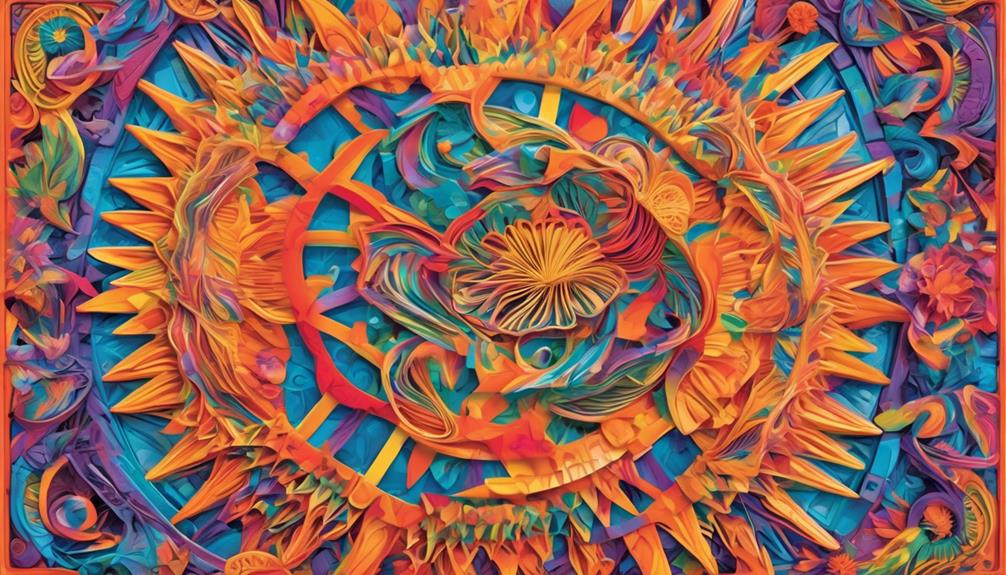
Let's talk about how the right border color can make a bulletin board pop, drawing attention and adding visual interest.
We'll also explore creative border designs that can complement the theme or purpose of the board.
Lastly, we'll share some practical tips for maintaining the borders to ensure they stay vibrant and eye-catching.
Border Color Selection
To enhance the visual appeal of a bulletin board, consider incorporating colorful and eye-catching borders to grab attention and add vibrancy to the display. When choosing border colors, it's essential to consider color psychology and pattern selection.
Here are some tips to help you select the perfect border color for your bulletin board:
- Contrast: Opt for bold, contrasting colors to make the borders stand out and draw attention.
- Complement: Choose border colors that complement the overall theme of the bulletin board to create a cohesive and visually appealing display.
- Warm or Cool Tones: Consider the mood you want to evoke and select warm or cool tones accordingly.
- Multi-color Borders: Experiment with multi-color borders to add a playful and dynamic touch to the bulletin board.
- Patterned Borders: Incorporate patterned borders to add visual interest and depth to the display.
Creative Border Designs
When creating colorful and eye-catching borders for a bulletin board, we can explore various creative designs to enhance its visual appeal.
Pattern variety adds an exciting element to the border, such as zig-zag, polka dots, or chevron patterns.
Mixing and matching materials like ribbons, washi tape, and patterned paper can create a dynamic and tactile border.
By combining different textures and shapes, we can make the border visually engaging and touchable, drawing people in to see what's on the board.
The use of contrasting colors and playful designs can also make the border stand out and complement the content displayed.
Border Maintenance Tips
Exploring creative border designs not only enhances the visual appeal of a bulletin board but also requires regular maintenance to ensure its continued attractiveness and impact. Here are some maintenance tips to keep your borders looking fresh and eye-catching:
- Regular Cleaning: Wipe the borders with a damp cloth to remove dust and dirt.
- Repair Damages Promptly: Fix any peeling or damaged parts to maintain a neat appearance.
- Seasonal Updates: Change the borders according to seasons or themes for ongoing inspiration.
- Color Touch-Ups: Keep touch-up paint handy to maintain vibrant colors and prevent fading.
- Attention to Detail: Regularly inspect the borders for any wear and tear, and make necessary touch-ups promptly.
Incorporate Various Textures and Materials
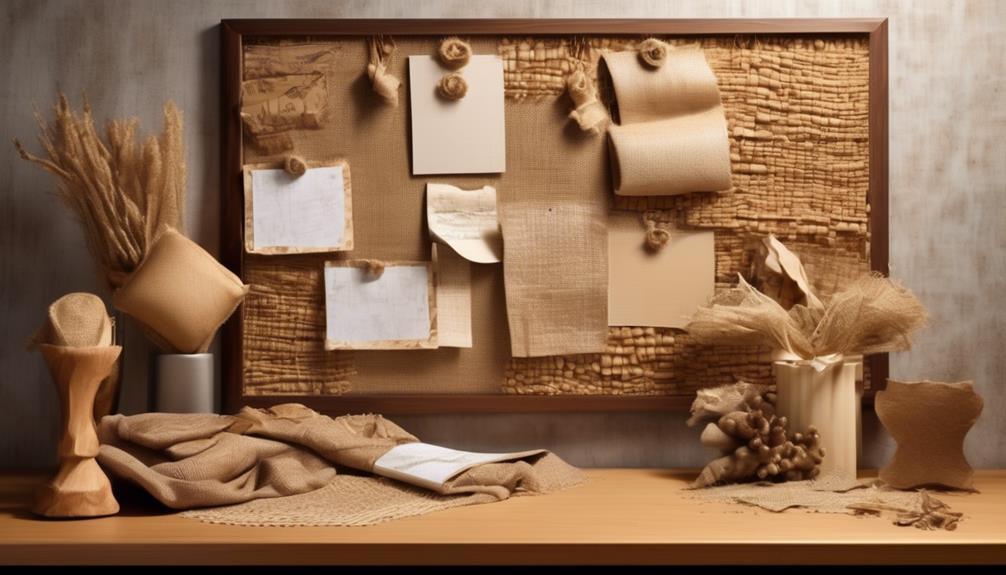
When we incorporate various textures and materials into a bulletin board, we add depth and visual interest.
By combining different textures, such as fabric, paper, and embellishments, we create a dynamic and engaging display.
This approach allows us to infuse creativity and personality into the bulletin board, making it more appealing to our audience.
Texture and Color
Incorporating various textures and materials into a bulletin board design adds visual interest and depth, making it more attractive and engaging for viewers. When considering texture and color, it's essential to understand color psychology and texture contrast to create a captivating display. Here's how we can achieve this:
- Mix and Match: Combine different textures such as fabric, paper, and wood to add dimension and tactile appeal.
- Color Combinations: Utilize color psychology to evoke specific emotions or reactions, such as using calming blues and greens or stimulating reds and oranges.
- Layering: Experiment with layering materials to create visual interest and depth, drawing the viewer in for a closer look.
- Contrast: Play with texture contrast by pairing rough and smooth materials, creating a dynamic visual impact.
- Accents: Incorporate metallic or reflective elements to enhance the overall texture and add a touch of elegance.
Visual Interest
Considering the impact of texture and color on bulletin board design, we can enhance visual interest by skillfully incorporating various textures and materials. Creative display is key to making a bulletin board visually appealing.
Mixing materials like fabric, paper, and wood can add depth and tactile interest to the display. For example, using a burlap background with colorful felt cutouts can create a dynamic and inviting visual experience. Additionally, incorporating elements such as buttons, ribbons, or natural objects like leaves and twigs can further enhance the overall texture and visual appeal of the bulletin board.
Add Dimension With Layered Elements
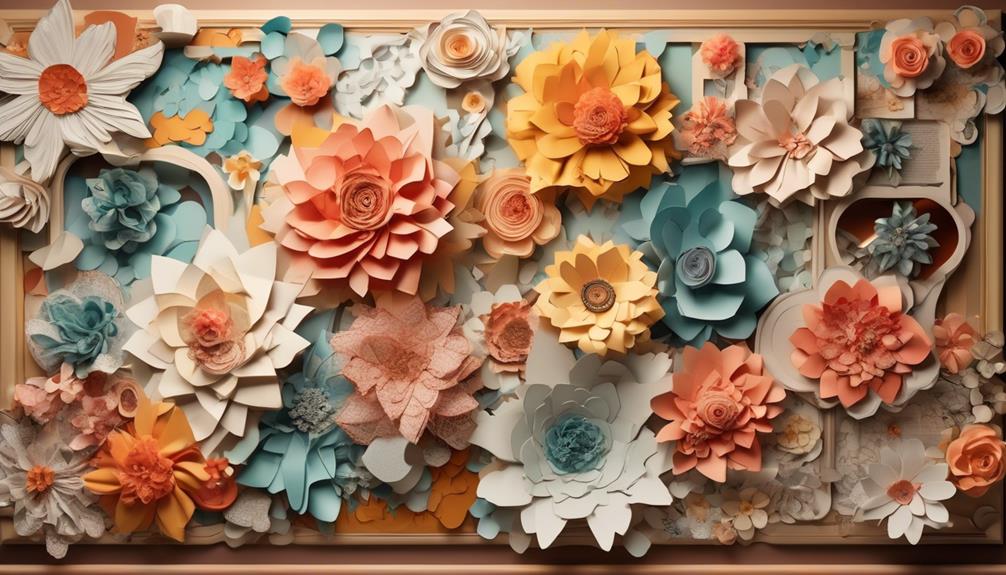
To add dimension to a bulletin board, consider using layered elements such as cutouts, borders, or raised accents. Dimensional layering adds depth and visual interest to the design composition, making the bulletin board more attractive and engaging.
Here are some ideas to enhance the visual impact:
- Cutouts: Utilize die-cut shapes or letters to create a layered effect. For example, layer a smaller cutout on top of a larger one to add depth and dimension.
- Borders: Incorporate borders made of different materials such as fabric, washi tape, or ribbon. Layering borders can frame the board and draw attention to specific content.
- Raised Accents: Use foam adhesive or double-sided tape to add raised accents like stickers, embellishments, or small objects. By layering these elements, you can create a tactile and visually interesting display.
- Mixed Media: Combine various materials like paper, fabric, and wood to create a multi-dimensional look. Layering different textures and finishes adds richness and complexity to the overall design.
- Shadowing: Experiment with shadowing techniques by layering elements at varying distances from the board. This creates a sense of depth and movement, making the bulletin board more dynamic.
These layered elements can transform a standard bulletin board into a captivating and visually appealing focal point.
Integrate Creative and Functional Organization

Let's explore how we can infuse both creativity and practicality into the organization of the bulletin board.
Functional storage is key to keeping the board tidy and efficient. Consider using baskets, shelves, or pockets to store supplies like markers, push pins, and sticky notes. This not only keeps things organized but also adds a decorative touch.
Utilizing creative display techniques can also enhance the functionality of the bulletin board. Try incorporating a calendar, to-do list, or a section for important documents. You can use colorful washi tape to create sections or borders, making the board visually appealing while also providing clear organization.
Another idea is to use clipboards or magnetic boards to display papers or notes that need to be easily accessible.
Showcase Engaging Visual Content

We've established the importance of integrating creative and functional organization to enhance the bulletin board, and now we'll focus on showcasing engaging visual content that captivates the viewers' attention and serves a dual purpose of both aesthetic appeal and informational value.
- Visual storytelling: Incorporate images, infographics, and illustrations to visually convey messages and narratives, making the content more engaging and memorable.
- Interactive engagement: Utilize interactive elements such as QR codes, pull-out tabs, or tactile materials to encourage viewers to actively participate and explore the information displayed.
- Varied textures and materials: Enhance visual interest by incorporating diverse textures and materials like fabric, wood, or metal to add depth and dimension to the bulletin board.
- Bright colors and contrasting elements: Use vibrant colors and contrasting elements to draw attention and create visual impact, making the content stand out and be easily noticeable.
- Rotating or changing displays: Keep the content fresh and engaging by regularly updating or rotating the visual displays, ensuring that viewers remain intrigued and interested in the bulletin board.
Utilize Interactive and Changeable Features

Embracing interactive and changeable features on a bulletin board ensures active engagement and dynamic information presentation. Interactive elements, such as QR codes linked to additional resources or interactive quizzes related to the displayed content, can pique viewers' interest and encourage them to participate in the learning process. Changeable displays, such as Velcro-backed posters or interchangeable sections, allow for easy updates and customization, keeping the content fresh and relevant. These features not only make the bulletin board visually appealing but also foster a sense of involvement and interactivity among the audience.
Furthermore, incorporating elements like flip cards, sliding panels, or rotating displays adds a tactile dimension to the board, inviting viewers to physically interact with the information. This hands-on approach can enhance the overall experience and make the content more memorable. By leveraging these interactive and changeable features, we create an immersive and dynamic environment that captures attention and encourages ongoing engagement.
It's all about making the bulletin board a living, evolving entity that sparks curiosity and invites active participation.
Introduce Personalization and Customization

Let's make our bulletin board more personal and unique by incorporating student work. By personalizing and customizing the board to reflect the interests and achievements of the students, we can create a more engaging and visually appealing display. Adding pops of color and texture will further enhance the aesthetic appeal.
Additionally, seeking input from the students will foster a sense of ownership and pride. By involving them in the process, we can ensure that the bulletin board truly represents their interests and accomplishments.
Use Student Work
Using student work to personalize and customize a bulletin board can make it more engaging and relatable for the entire school community.
When we incorporate student collaboration, the bulletin board becomes a reflection of our collective efforts and achievements. It fosters a sense of pride and belonging among students, teachers, and parents.
Project displays showcase the diverse talents and creativity within our school, inspiring others to contribute and participate. Seeing their own work featured on the bulletin board encourages students to take ownership of their learning environment, promoting a positive and inclusive school culture.
Additionally, it provides an opportunity for everyone to celebrate the unique perspectives and contributions of each individual, creating a vibrant and dynamic display that truly represents our school community.
Add Color and Texture
Incorporating vibrant colors and diverse textures not only enhances the appeal of the bulletin board but also introduces personalization and customization, further engaging the school community.
Colorful patterns add a dynamic and lively touch to the display, drawing attention and sparking interest.
Utilizing textured backgrounds provides depth and dimension, creating a tactile experience for viewers. By mixing and matching various textures, such as fabric, paper, and 3D elements, we can create a visually stimulating and interactive board.
The use of bright, bold colors combined with different textures can evoke different emotions and set the tone for the board, whether it's cheerful and energetic or calming and introspective.
This personalized approach fosters a sense of ownership and belonging within the school community, making the bulletin board a true reflection of our unique identity and spirit.
Incorporate Student Input
Student input plays a crucial role in personalizing and customizing the bulletin board to reflect the unique identity and interests of our school community. Our approach to incorporating student input involves true collaboration and design feedback, ensuring that the bulletin board is a true reflection of our collective identity. Here's how we do it:
- Brainstorming Sessions: We gather students to share their ideas and suggestions for the bulletin board.
- Design Contests: Students participate in design contests where they can submit their creative ideas for the board.
- Interactive Surveys: We conduct surveys to gather opinions on themes, colors, and content preferences.
- Student Showcases: Students are given the opportunity to showcase their work and interests on the bulletin board.
- Regular Feedback Loops: We maintain open channels for ongoing feedback and suggestions from students.
This collaborative approach ensures that the bulletin board truly represents our diverse and dynamic school community.
Implement Thematic and Seasonal Decor
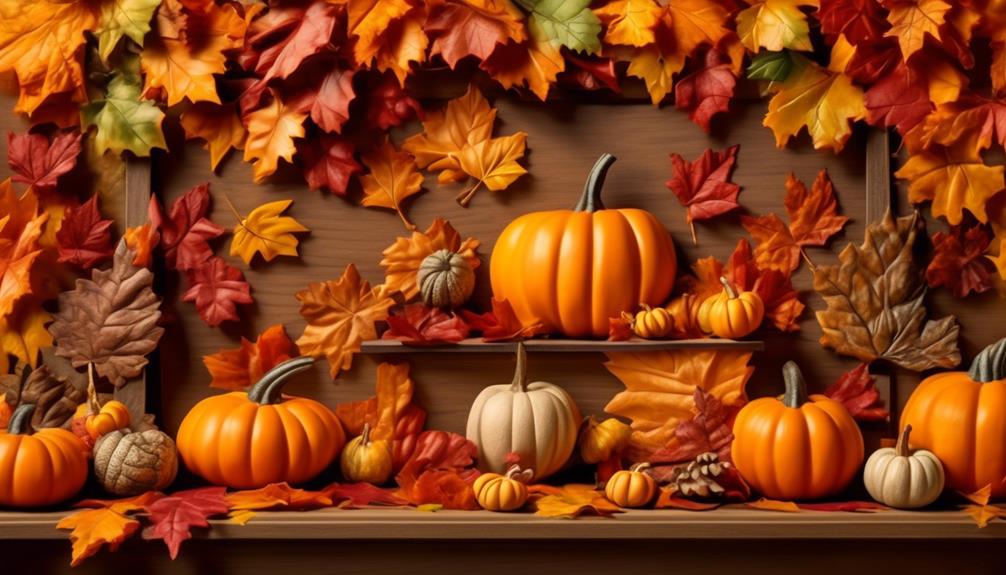
Decorating a bulletin board with thematic and seasonal elements can instantly capture attention and create an inviting atmosphere. Seasonal themes like autumn leaves, snowflakes, or blooming flowers can add a pop of color and bring the spirit of the season indoors. Incorporating decorative accents such as mini pumpkins for fall, paper snowflakes for winter, or sunflowers for summer can infuse the board with a lively and engaging feel. When we change the decor to match the time of year, it shows that we're tuned in to the world around us and helps create a sense of connection and community.
Thematic decor can also tie in with classroom lessons or school events, making the bulletin board not only attractive but also educational and relevant. For example, during Black History Month, we can feature influential figures and their achievements. This not only adds visual interest but also sparks important conversations.
Employ Lighting and Display Techniques
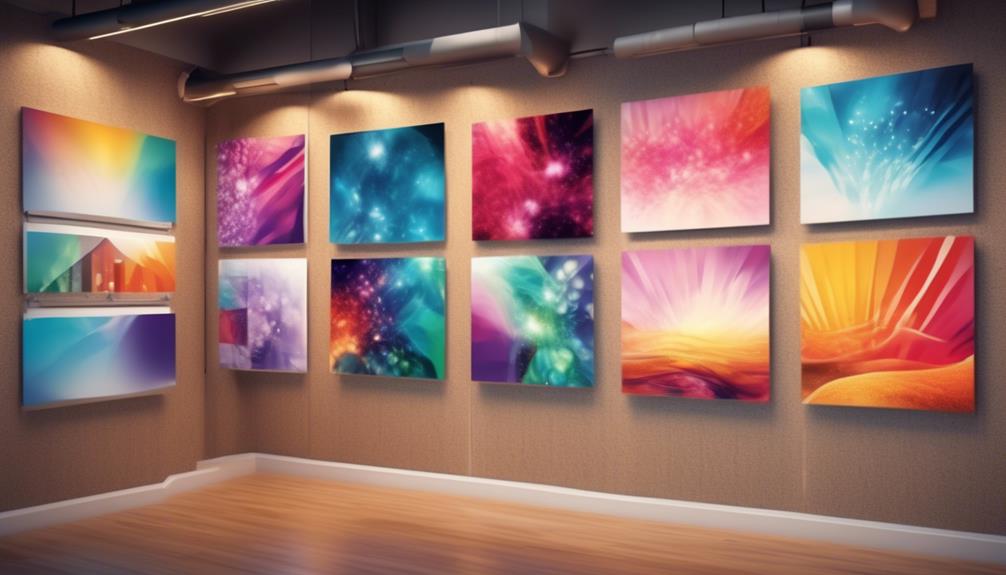
Using strategic lighting and display techniques can enhance the appeal and visual impact of a bulletin board, drawing attention and creating a dynamic focal point within the classroom. When considering lighting placement and display arrangement, it's essential to create an inviting and engaging atmosphere that encourages students to interact with the board.
Here are some tips to achieve this:
- Accent Lighting: Position spotlights or track lighting to illuminate specific areas of the bulletin board, highlighting important information and creating visual interest.
- Natural Light: Take advantage of natural light by positioning the bulletin board near windows to enhance visibility and create a vibrant display.
- Layered Display: Incorporate depth and dimension by layering materials such as fabric, paper, and 3D objects to add texture and visual intrigue.
- Interactive Elements: Integrate interactive elements such as flip cards, pull tabs, or movable pieces to engage students and encourage participation.
- Thematic Arrangement: Organize the display to tell a story or convey information in a logical and visually appealing sequence, guiding viewers through the content.
Frequently Asked Questions
How Can I Incorporate Technology or Digital Displays Into My Bulletin Board Design?
Incorporating technology and digital displays into a bulletin board design can enhance digital engagement and foster interactive learning. By integrating interactive elements like QR codes, touchscreens, or digital content, we can create a dynamic and engaging experience for our audience.
This approach not only modernizes the traditional bulletin board but also provides an opportunity for deeper and more immersive learning experiences. It's an exciting way to make information more accessible and engaging.
Are There Any Special Considerations for Making a Bulletin Board Accessible for Individuals With Visual Impairments?
When making our bulletin board accessible for individuals with visual impairments, we focus on inclusive materials and accessible design.
It's essential to consider using tactile elements, such as braille or raised textures, and high-contrast colors to enhance readability.
We aim to create an inclusive environment where everyone can engage with the information presented.
What Are Some Creative Ways to Incorporate Interactive Elements, Such as Games or Puzzles, Into a Bulletin Board?
Incorporating interactive elements like puzzle challenges and game-based learning can really spice up a bulletin board.
We could use interactive storytelling to engage viewers and encourage artistic collaboration.
By creating a platform for participation, we can make the bulletin board a dynamic and fun learning environment.
This approach not only makes the board more attractive, but also encourages active involvement and creativity from the audience.
How Can I Make My Bulletin Board More Environmentally Friendly or Sustainable?
Upcycling materials and using eco-friendly decorations are great ways to make our bulletin board more environmentally friendly and sustainable.
It's important to consider the impact of our choices on the planet. We can use old magazines or newspapers for colorful backgrounds, or repurpose old fabric for borders.
Adding potted plants or small succulents as decor not only looks great but also promotes a green atmosphere.
Are There Any Legal or Ethical Considerations to Keep in Mind When Displaying Certain Types of Content on a Bulletin Board, Such as Copyrighted Material or Sensitive Information?
Legal implications and ethical considerations are crucial when displaying content on a bulletin board. We need to ensure that we're not infringing on any copyrights or sharing sensitive information. It's important to respect intellectual property rights and privacy.
We must be mindful of the impact our content may have on others. By being respectful and responsible, we can create a welcoming and inclusive bulletin board environment for everyone.
Conclusion
In conclusion, creating an attractive bulletin board is all about being creative and using the right techniques.
As the saying goes, 'You never get a second chance to make a first impression.' So, make sure to choose the right background, use colorful borders, add dimension, and incorporate interactive features to make your bulletin board stand out.
Remember, a well-designed bulletin board can make a big impact and leave a lasting impression on your audience.
- About the Author
- Latest Posts
Introducing Ron, the home decor aficionado at ByRetreat, whose passion for creating beautiful and inviting spaces is at the heart of his work. With his deep knowledge of home decor and his innate sense of style, Ron brings a wealth of expertise and a keen eye for detail to the ByRetreat team.
Ron’s love for home decor goes beyond aesthetics; he understands that our surroundings play a significant role in our overall well-being and productivity. With this in mind, Ron is dedicated to transforming remote workspaces into havens of comfort, functionality, and beauty.
-

 Vetted4 weeks ago
Vetted4 weeks ago15 Best Contact Paper for Kitchen Cabinets to Elevate Your Home Decor
-

 Vetted2 weeks ago
Vetted2 weeks ago15 Best Poe Cameras for Home Security – Reviews & Buying Guide
-

 Vetted4 weeks ago
Vetted4 weeks ago15 Best Drain Snakes to Unclog Your Pipes Like a Pro
-

 Beginners Guides1 week ago
Beginners Guides1 week agoI Inhaled Vinegar Fumes
-

 Beginners Guides3 weeks ago
Beginners Guides3 weeks agoSwinger Porch Light Color
-

 Mardi Gras Decoration4 weeks ago
Mardi Gras Decoration4 weeks agoWhy Does Hobby Lobby Not Do Mardi Gras?
-

 Vetted4 hours ago
Vetted4 hours ago15 Best Hot Tubs of 2024: Luxurious Relaxation at Your Fingertips
-

 Vetted2 weeks ago
Vetted2 weeks ago15 Best Blinds for Bathroom Windows to Enhance Privacy and Style























![Best Nautical Bathroom Accessories for a Seafaring Home [2024] 354 81qrq833mjL](https://byretreat.com/wp-content/uploads/2023/11/81qrq833mjL-80x80.jpg)